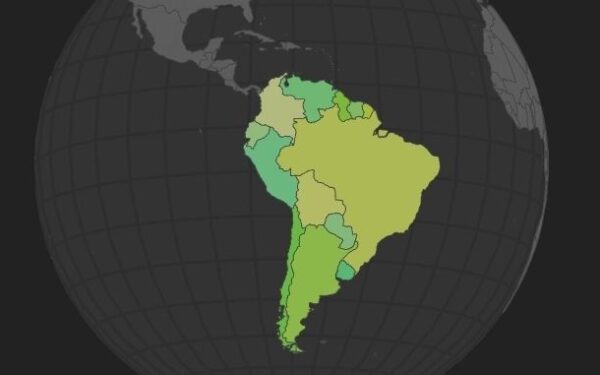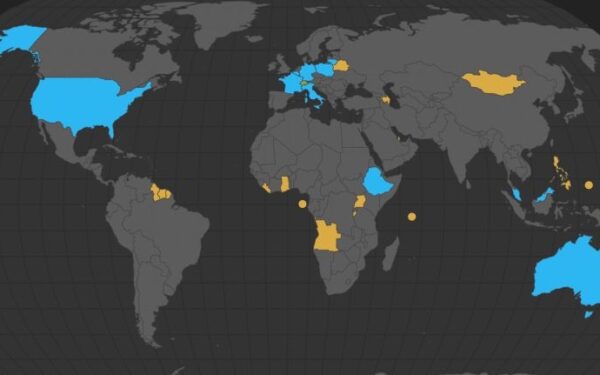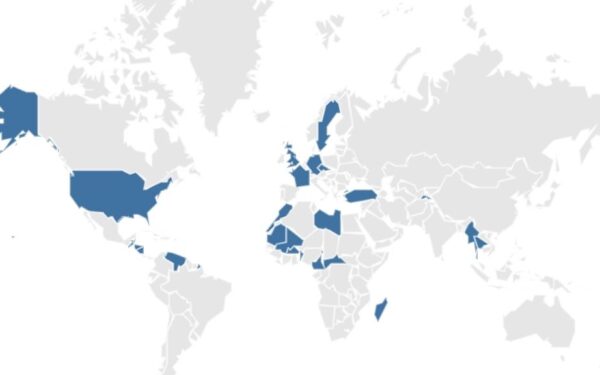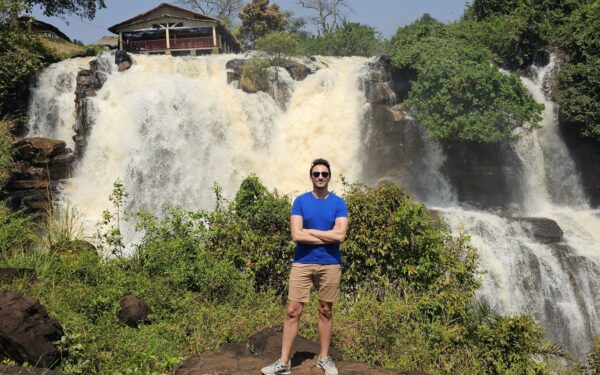Travel report: Colombia
Country ranking by area: #26
Country ranking by population: #29
Date of visit: December 2018
My trip to Colombia started with a pleasant surprise: the 11-hour flight with Air France (!) was absolutely perfect!
I usually avoid Air France like a vegan avoids a plate of delicious spare ribs. Seriously, I was always willing to pay 200-300€ more by taking another airline, but in this case I had no other choice. Traveling around Christmas and New Year is the most expensive period of the year, and Air France was the only airline that offered flights to Colombia for a reasonable price. Lufthansa, for example, was double the price.
Why do I avoid Air France? Because during 50% of the flights something goes wrong, be it a lost piece of luggage, a long delay, a crash or a cancellation. Moreover, Charles de Gaulle Airport is one of the worst in Europe if you have to change the plane in a hurry. My expectations were quite low therefore, but the flight turned out to be great. The seats were comfortable, the inflight entertainment system was almost as big as the monitor of my notebook and the food was also more than okay.
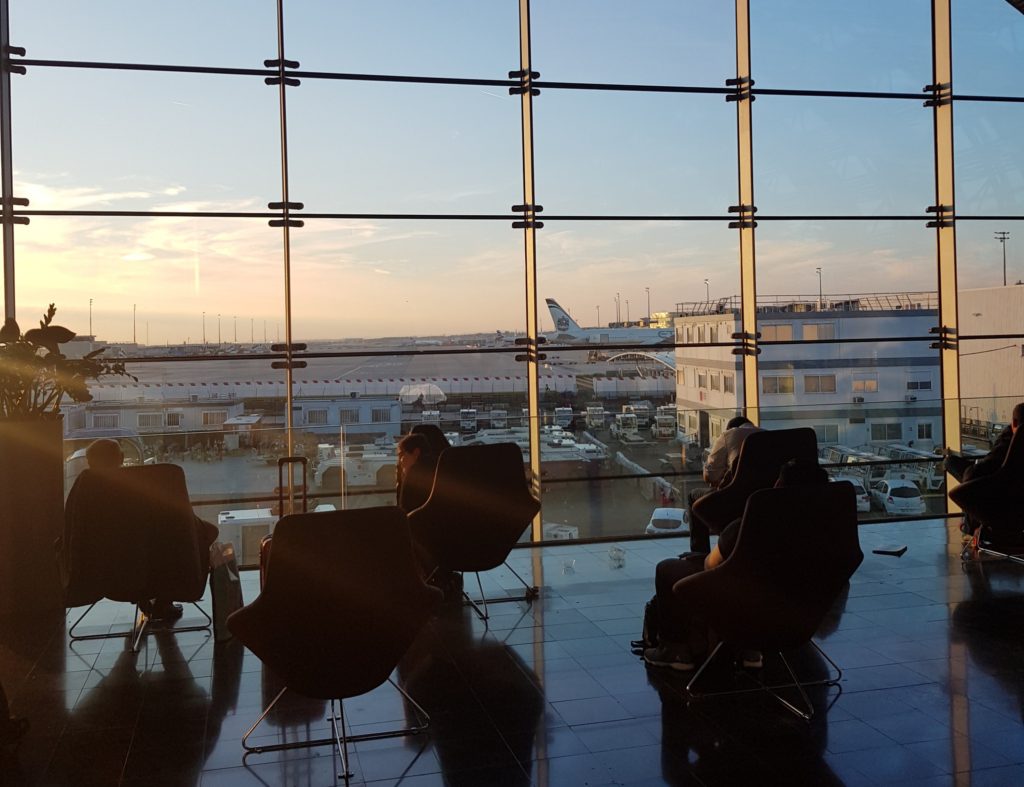
In all fairness, I have to admit that I made bad experiences with all major European airlines in the past few years (except for Turkish Airlines. They exceeded my expectations every time). That’s why I am going to see Air France as a valid option in the near future, or at least until the next bad incident happens.
Colombia – country number 79
People usually associate Colombia with drug cartels, guerilla rebels, para military, kidnappers and other criminals and I assume that the country is still an extreme travel destinations to many people therefore. While Colombia has been one of the most dangerous countries a few decades ago, times have changed now and the country has become one of the trendiest travel destinations in the last few years. Is the country 100% safe nowadays? I wanted to find out.
As a side note, Colombia should have become my country #27 and my first country in South America in early 2015. We changed our plans back then and headed to Brazil instead. A second attempt failed too. I planned to visit Colombia in May 2018, but found out that May is the rainiest month in Bogota and Medellin. I opted for Peru therefore and I didn’t believe that I would still visit Colombia in the same year. All good things come in threes though.
It was 10 PM, when I landed in Bogota, the capital of Colombia. I was six hours behind Central European Standard Time, what means that it was already 4 AM back home. Needless to say that I was tired. As soon as I logged into the airport Wifi I read a message from my hotel that they were overbooked and I was transferred to another hotel therefore. Well, it wasn’t my only problem with hotels during that trip, but it didn’t bother me back then. The new hotel was not far away from the hotel I originally booked, and it seemed that it offered the same standard.
An Uber took me Zona Rosa, Bogota’s tourist district. It was chilly (almost cold), as Bogota’s elevation is over 2,600 meters. That makes Colombia’s capital one of the highest in the world. I didn’t get enough time to get a real impression of Bogota during the 20-minute car ride, because the Uber driver kept talking without a break, although I told him that I don’t speak Spanish. That didn’t stop him though. He kept talking about the nice ladies in Medellin, offered me weed and cocaine, and started to sing Rammstein’s “Du hast” after I told him that German was my mother tongue.
Although I was tired after a long day, I just entered my 79th country and the day couldn’t end just like that. A bottle of beer in a hipster bar/nightclub, which was in the same street as my hotel, seemed to be a more worthy end of that day. I also got a glimpse of Bogota’s nightlife, and it seemed to be a quite vibrant city with many things going on at night. The next evening should give me a deeper insight.
Bogota – first taste of Colombia
A few hours later, I was already on my feet again. I started my program by organizing a few things like getting a local SIM card, which turned out to be a quick and easy affair. After that, I finally had time to get an impression of Bogota.
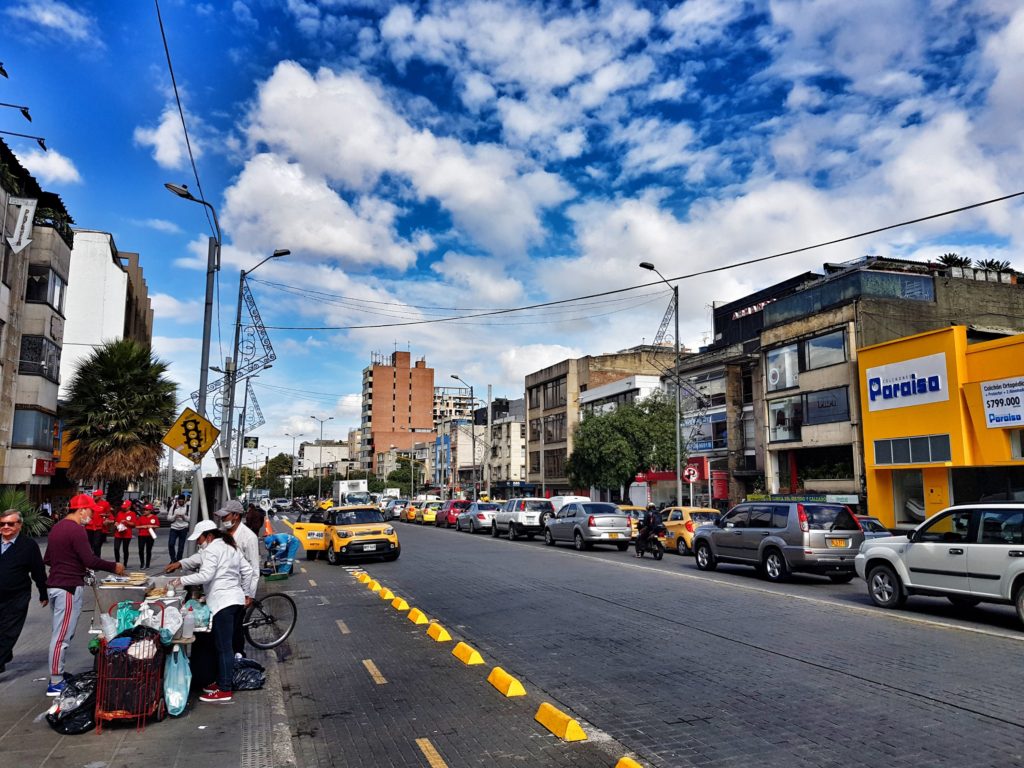
Bogota was my fourth major city in South America after visiting Rio de Janeiro, São Paulo and Lima before. The city that is the most similar is without a doubt Lima. Both cities have more or less the same population (Bogota has 8 million, whereas Lima has 8.5 million), both are incredibly big and both lack sights. Okay, that might sound a bit harsh, but it doesn’t take a lot of time to see all of Bogota’s attractions.
I had two full days in the capital, and I spent these days by visiting the historical center in La Candelaria, going up Mount Montserrate, drinking Colombian coffee and having a few longdrinks in Zona T, the nightlife district. To be honest, one full day would have been enough for that. As I said, it’s a huge city and it can take ages to get from one point to another. A ride from Zona Rosa to La Candelaria takes about 45 minutes due to the bad traffic in the city. One way of course.
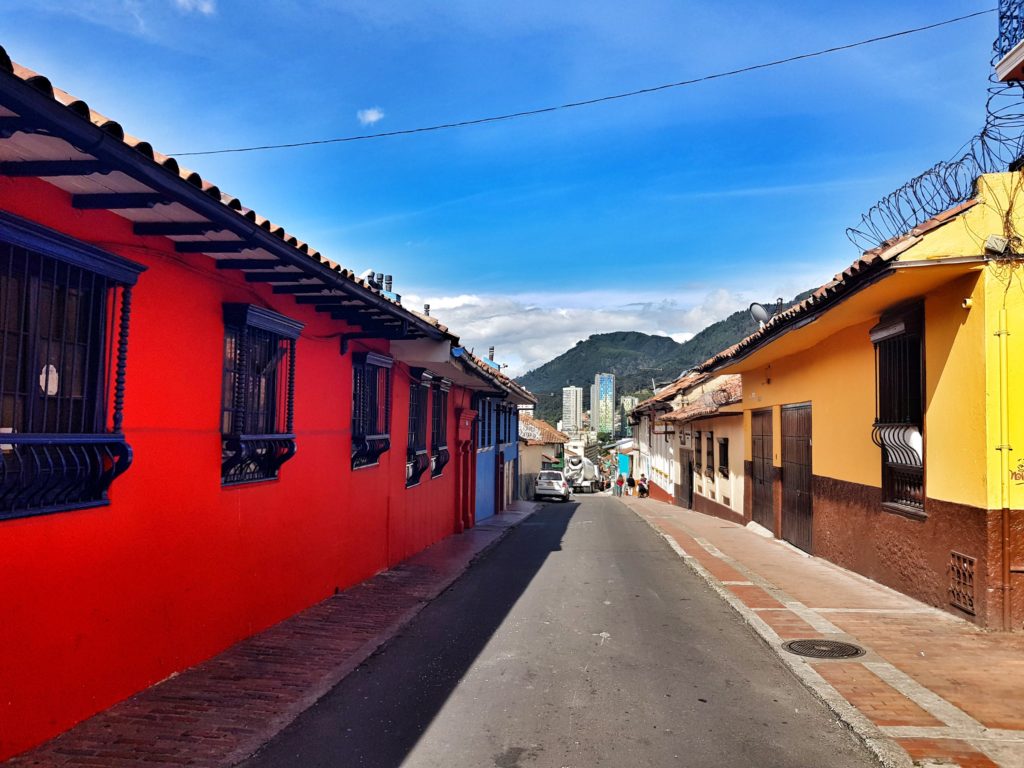
La Candelaria is a neighborhood you have to see when in Bogota. It’s actually the most beautiful part of the city, or at least the most beautiful part I have seen. Like in many other Latin American cities, the heart of the historical center is a square with a big cathedral on one side. Plaza Bolívar is the name of that square in Bogota. In the end, all these plazas look quite similar no matter if you’re in Lima, Arequipa, Quito or Bogota. It’s a remnant of the Spanish.
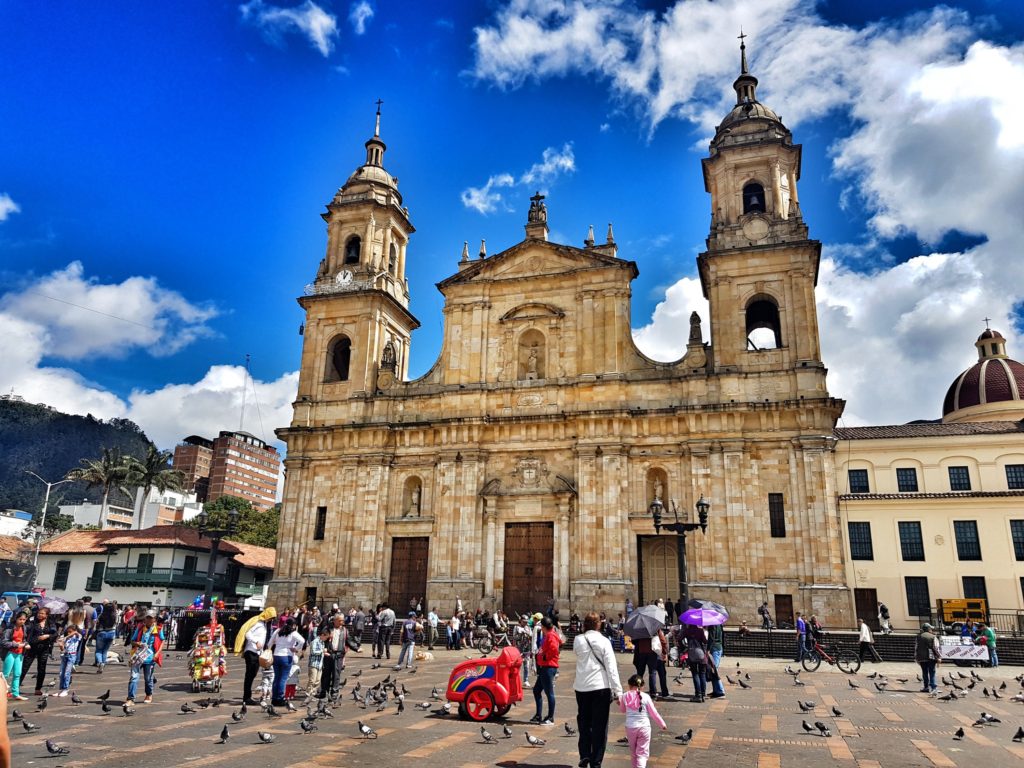
I could have gone to the art museum (Museo Botero) or the gold museum (Museo del Oro), which are both in La Candelaria, but I rarely visit museums when I travel. Bogota is a city for art-lovers though and both museums have the reputation of being outstanding. You can also see art on the street. People sell their paintings in La Candelaria, and one of the most popular activities in Bogota are graffiti tours.
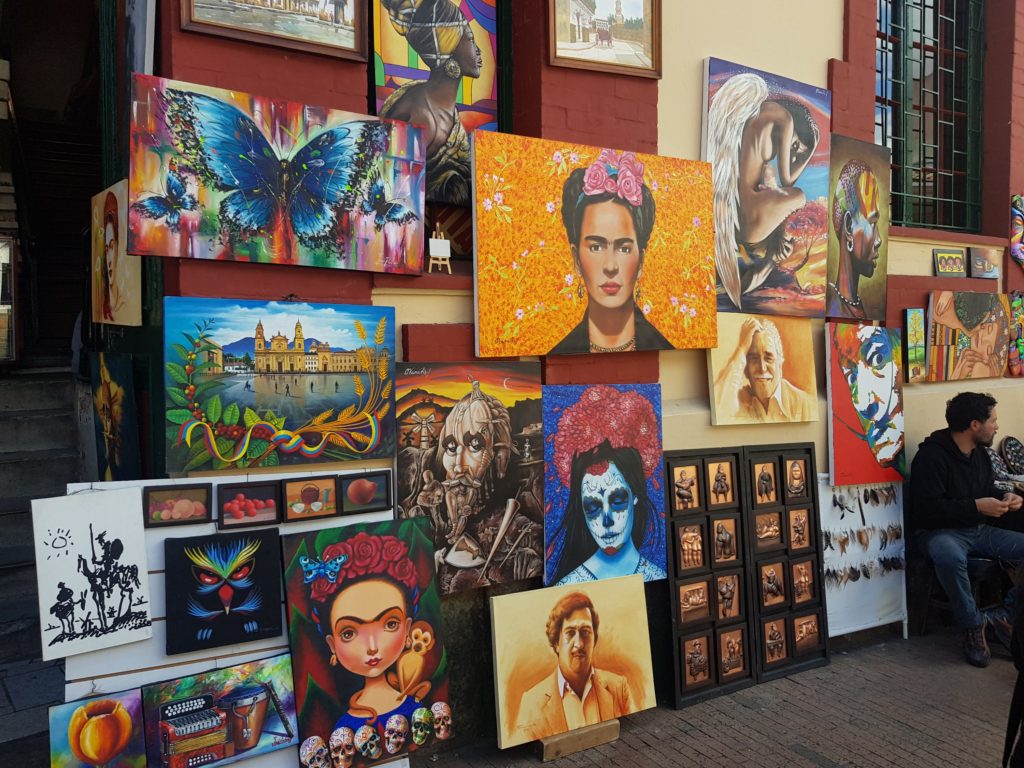
It was also time for my first Colombian meal. There are many restaurants that serve a meal of the day, which usually consists of a soup, a main course, a side salad and a drink. Well, I didn’t even realize that I was in that kind of a restaurant until the waitress put a bowl of lentil soup on my table. I had no idea what the main course would be and it turned out to be spaghetti pesto. Not exactly the Colombian meal I was looking for, but what can you do when your Spanish is limited.
Yeah, I had some problems with the communication. When I entered Colombia, I knew maybe 50-100 words in Spanish. However, I almost always self-confidently answered the questions of the locals with a si or a no. Even if I didn’t understand the question, which was the case most of the time. Sometimes, a waitress looked at me quite irritated when I answered a question with si. I changed my mind then and said no just to find out a few moments later that the question was if I wanted my scrambled eggs with ham OR cheese. Si.
One night in Bogota
Bogota can become a bit dodgy at night. Or let’s say very dangerous depending on the district you are. Zona Rosa is the safest part of the city. That doesn’t mean that there aren’t any shady people around at night, but the strong presence of the police makes it a district, in which you can walk around at night without a problem.
Zona T is the famous nightlife district in Zona Rosa. You can find plenty of bars, restaurants and nightclubs there. It was a Friday and there were thousands of people on the streets. The streets were so crowded so that you had to wait in line before entering a bar. Crazy.
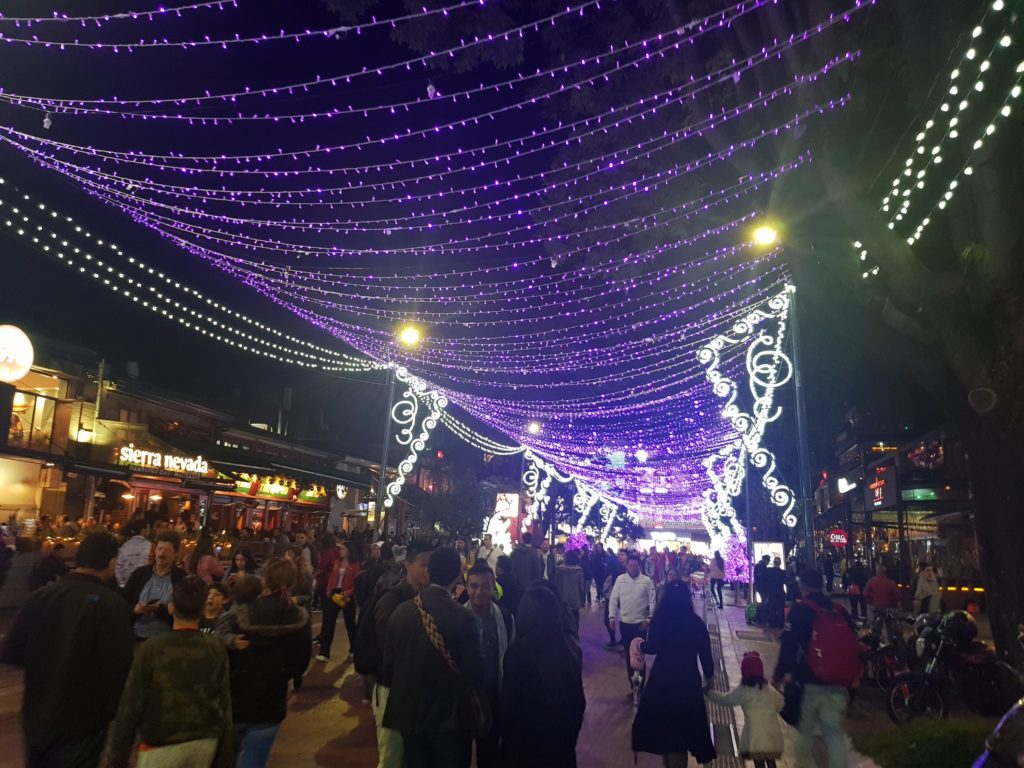
I didn’t say anything about the people in Colombia yet. The Colombians are among the best people I have ever met. They are friendly, they laugh a lot, they dance, they are simply a cool bunch. Although I had problems communicating with them sometimes, I always felt welcome. The only black sheep was a guy I met the day after, but I will come back to that shortly…
So, there I was… alone among great people, sipping two or three drinks when I suddenly ran out of money. Unfortunately, many Colombian banks didn’t accept my bank card so that I had to search for an ATM. The search for an ATM in Bogota was thrilling. After failing at three ATMs in Zona Rosa, I asked a taxi driver to take me to the next one.
He drove me out of Zona Rosa and stopped at the first ATM in another neighborhood. No success. He continued driving but I did not success with the second one. Suddenly, I realized that we were already 20 minutes away from Zona Rosa. According to Google Maps, we were definitely leaving the areas that tourists visit.
After the third and fourth failed attempt, the taxi driver had enough. I gave him the last bit of money I had, while he left me at the fifth ATM in the middle of nowhere. It was around 2 AM and there were no people on the streets. I started walking. A few people passed by and I have to admit that I got a little nervous. Fortunately, I noticed a taxi coming after five minutes. I stopped it and told the driver to get me back to Zona Rosa.
I finally found an ATM when I got back. Honestly, I have no idea where I was exactly and how dangerous this situation was. I could have been in a safe district, but you don’t walk around in Bogota at night. At least, not outside of Zona Rosa or one or two other neighborhoods. Luckily, everthing went well.
Still Bogota… killing time
I had another full day in the capital of Colombia, because my flight to the next destination was at 9 PM. As I have already been to La Candelaria, I decided to see the other main attraction: Mount Montserrate.
Bogota is a city that is built around hills, and you’re driving up and down when you get from one point to another. That got me sick sometimes, and the bad driving style of the Colombian taxi drivers didn’t help either. On our way to Mount Monserrate, we also drove through Chapinero, one of the weirdest districts I have ever seen. Almost every house is built with red brick. And I am not talking about 15-20 houses but hundreds of them. If you didn’t know better, you would think that you were somewhere in Northern England.
TripAdvisor says that it can take more than an hour until you enter the aerial tram that takes you up the mountain. Fortunately, I didn’t have to wait longer than five minutes. Ten minutes later, I reached the station on top.
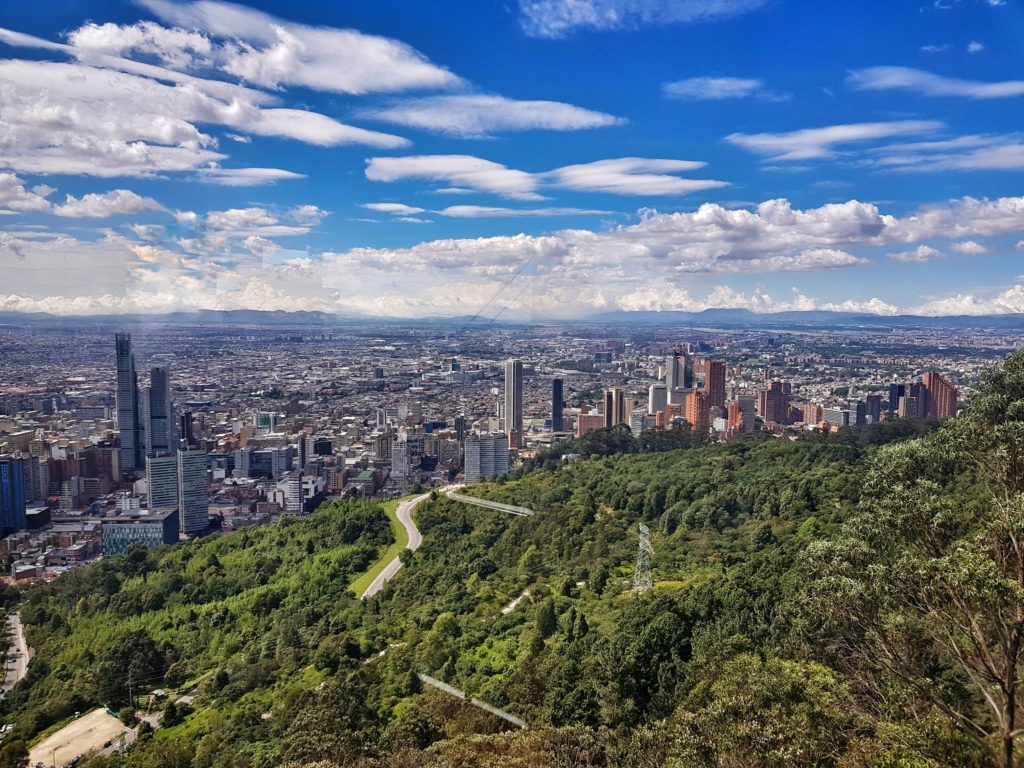
Mount Monserrate offers an amazing view over Bogota, and from up there I realized how enormous the capital city of Colombia is. 8 million people live here. My home country has the same population.
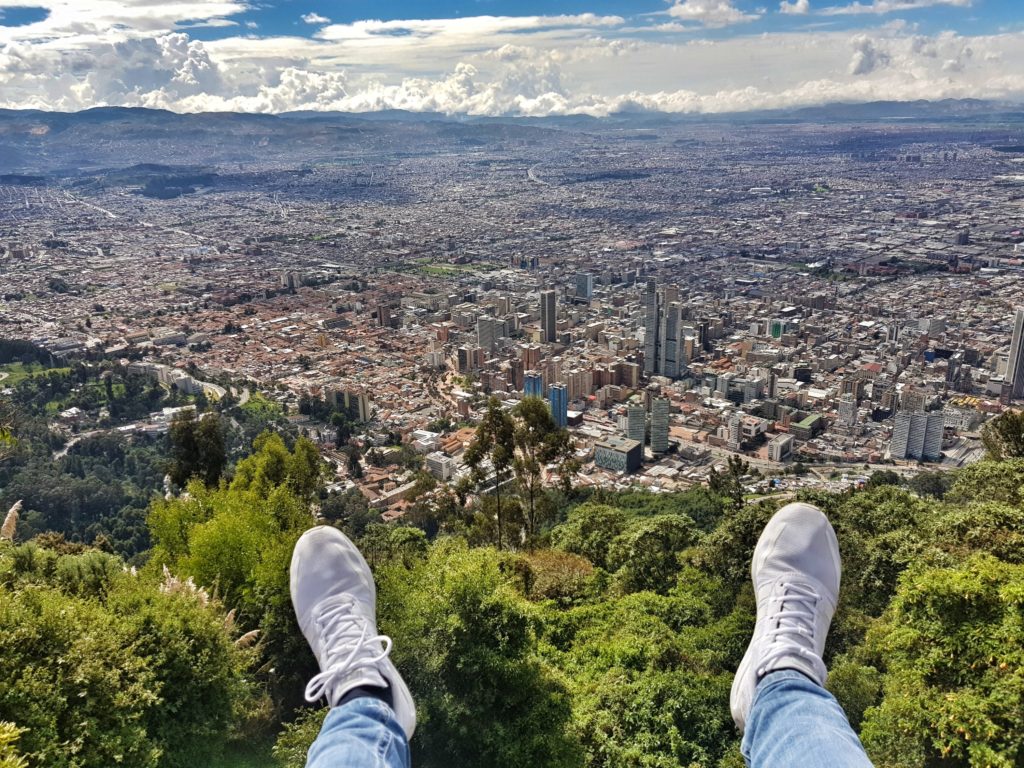
I got my only bad experience in Colombia on my way back from Mount Montserrate to Zona Rosa. There was no Uber nearby so that I opted for a taxi. As I had mentioned before, you drive up and down in hilly Bogota, and the driver was faster than a formula one pilot. As a consequence, I put on the seat belt for the first time in Colombia. The driving style wasn’t the bad experience though…
We had agreed on 22,000 pesos in the beginning, which was a bit expensive but I didn’t want to haggle too long just to save one or two Dollars. When I gave the driver a 20,000 and a 2,000 note, he didn’t seem to be happy with that. I didn’t understand what his problem was. He kept talking in Spanish and I eventually understood that he wanted smaller notes.
Nevertheless, he wasn’t happy either when I handed him out the smaller notes. He got louder and bank notes were exchanged back and forth. Finally, I thought that he put my 20,000 note into his pocket, however, I was confused because everything happened so fast. He still wanted the small notes and he was yelling at me.
At some point, I lost my patience as well. I was yelling back to him , especially after realizing that he locked the door and I couldn’t just walk away. I told him that I already gave him 20,000 and his answer was “you crazy!!”. In the end, I gave him the 22,000 in small bills as he wanted, but I was quite sure that he took another 20,000 of me prior to that. I couldn’t prove it though, and everything went too fast so that I couldn’t swear that he actually scammed me. It wasn’t a tragedy. I mean I would have lost 6 Dollars in the worst case, but situations like that are annoying.
My time in Bogota came to end now. Two days were actually more than enough, but I would be back for another day two weeks later. Time had come for my second stop in Colombia.
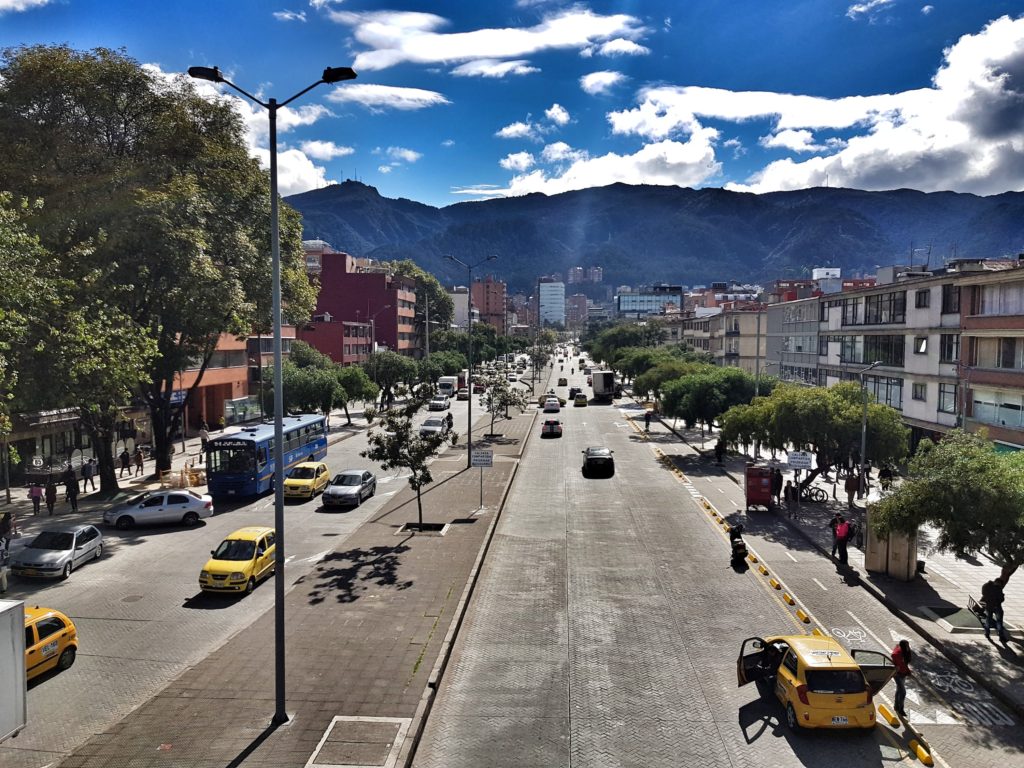
Off to San Andrés
The reason why I traveled to Colombia now were my friends Tobi and Jasmin, who started their world trip seven weeks earlier. I have been traveling solo the past two years apart from the weekend trips in Europe, but I wanted to spend a trip with friends again this time. The plan was to meet the two in San Andrés, a tiny island almost 800km away from mainland Colombia. What I didn’t know was that they wanted to surprise me. They had actually booked the same flights from Bogota and wanted to meet me at the gate in Bogota. The travel gods had other plans though…
When I arrived at the airport, I got a video call from the two. They had been stuck in Lima, as their flight from Lima to Bogota had a three-hour delay. That meant they wouldn’t make it to the plane from Bogota to San Andrés and would arrive at 4 AM instead, while my flight was scheduled to arrive at 11 PM. What a bummer. I even unsuccessfully tried to convince the Avianca crew to wait a little bit longer. It wouldn’t have been possible anyway, because Tobi’s and Jasmin’s plane arrived in Bogota approximately 40 minutes after our departure.
My plane landed in San Andrés on time. Google Maps said that my hotel was just a 7-minute walk from the airport, so I refused to take a taxi. I was still wearing my jacket, as I was traveling with hand luggage only (and had no space in it anymore), while walking towards my hotel. It must have been a hilarious image for the drunk locals on the streets witnessing a guy dressed like he was going to Antarctica arriving on a Caribbean island. Yes, I was in the middle of the Caribbean sea and actually way closer to Nicaragua than to Colombia.
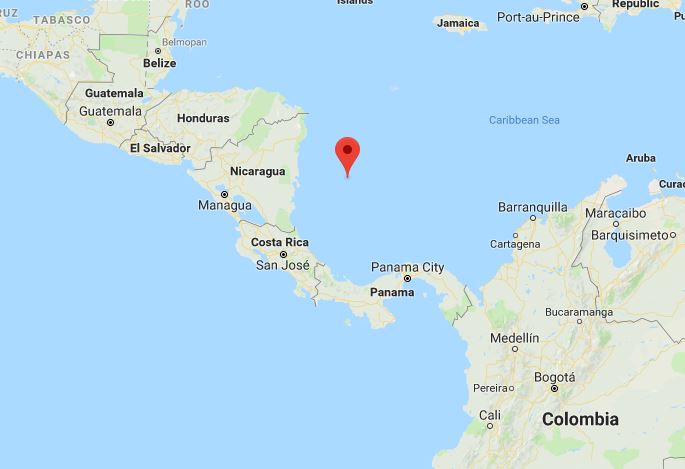
I have to admit that I had some problems adjusting to the new time zone, what is actually unusual when traveling from east to west. However, I only slept 4-5 hours in the first two nights, and I definitely needed some sleep therefore. But again, the travel gods did not want it to be like that. I got a call from Tobi. Their hostel sent them a message that they couldn’t check-in at 4 AM. The owner didn’t want to get up in the middle of the night just because of two delayed travelers.
The two asked me then if I could turn up the sound of my cell phone so that they could come to my hotel just for the case that they wouldn’t find a place to sleep. I couldn’t say no of course. It was 23.45, and I prepared myself for bed knowing that I might get a wake up call four hours later. I fell asleep after a few minutes.
Then, the phone ring woke me up. It must be 4 AM I thought, but it turned out that it was still 00.30! Tobi was on the phone asking me to check at the reception if another room was available. Drowsily I walked down the stairs just to find out that a) no one was down there anymore and b) that the front door was locked. Now the two were entirely on their own, as I couldn’t even open the door for them. I was staying in a Posada. That’s like a family owned bed and breakfast and the most common kind of accommodation in San Andrés. There is no such thing as a 24h-reception. The owners go to bed as soon as the last guest had arrived.
Paradise island
Fortunately, I woke up 9 hours later and found out that everything went well. The two could find a 4 star hotel and their travel insurance paid for it. I met the two at 10 AM in front of their hotel. We haven’t seen each other for two months and I was looking forward to hear their stories about the first weeks they spent on the road. They had just returned from an Ayurveda tour (…or something like that…) in the Peruvian jungle and spent some time in Argentina, Uruguay and Brazil before.
We had two days in San Andrés and we wanted to make the most of it. Getting around can be a bit difficult on that island if you don’t have your own vehicle. That’s why we rented a buggy for the next 36 hours.
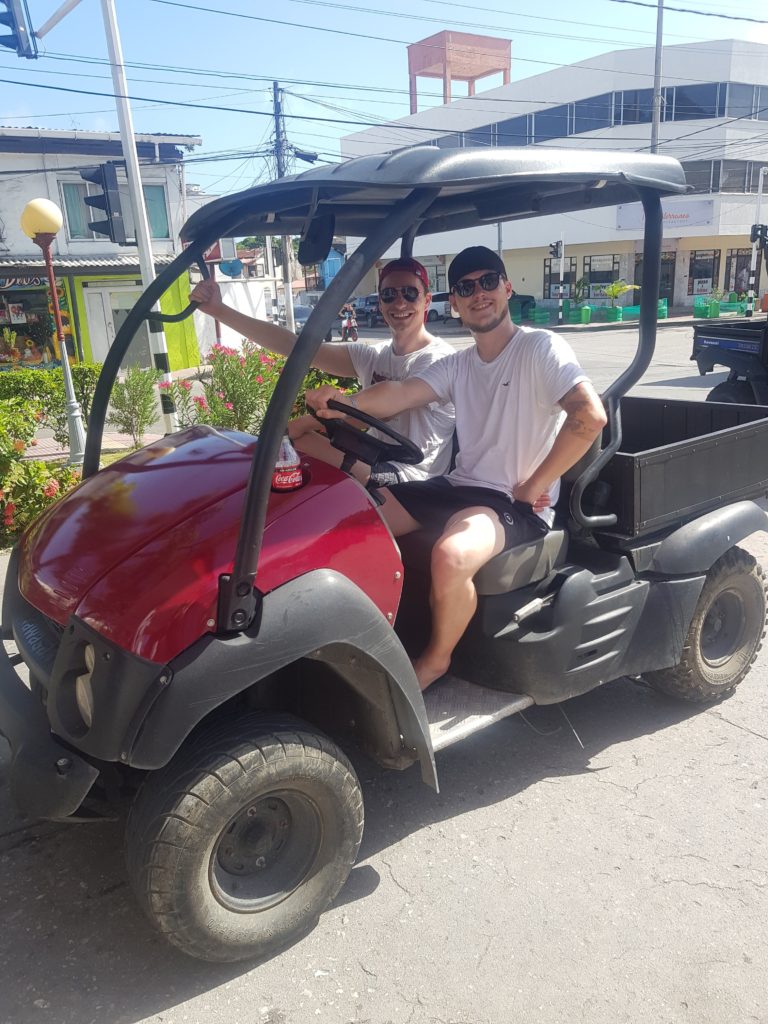
We had the entire afternoon to explore San Andrés and started with the eastern part of the island. It didn’t take us long to realize that traveling to San Andrés was a great choice. First, driving around with this buggy was a real blast. Second, the ocean we saw was absolutely amazing.
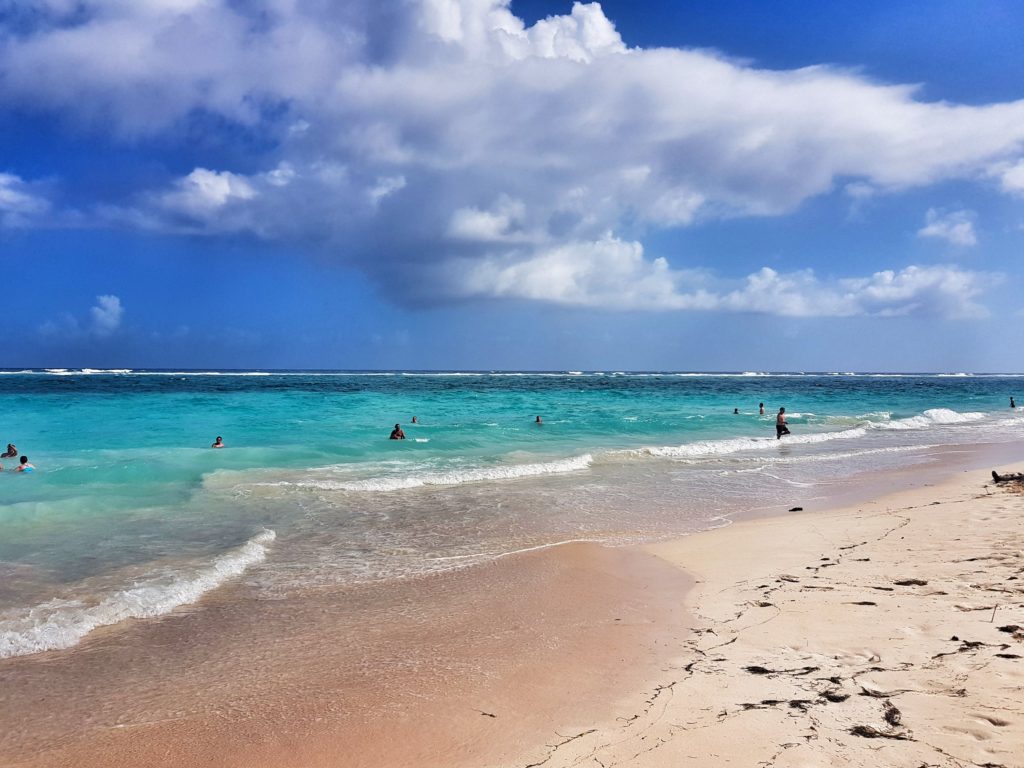
The last time I have seen such beautiful turquoise water was in the Bahamas, a country that is also located in the Caribbean. The only differences was that I actually liked San Andrés right from the beginning. I cannot say the same thing about the Bahamas.
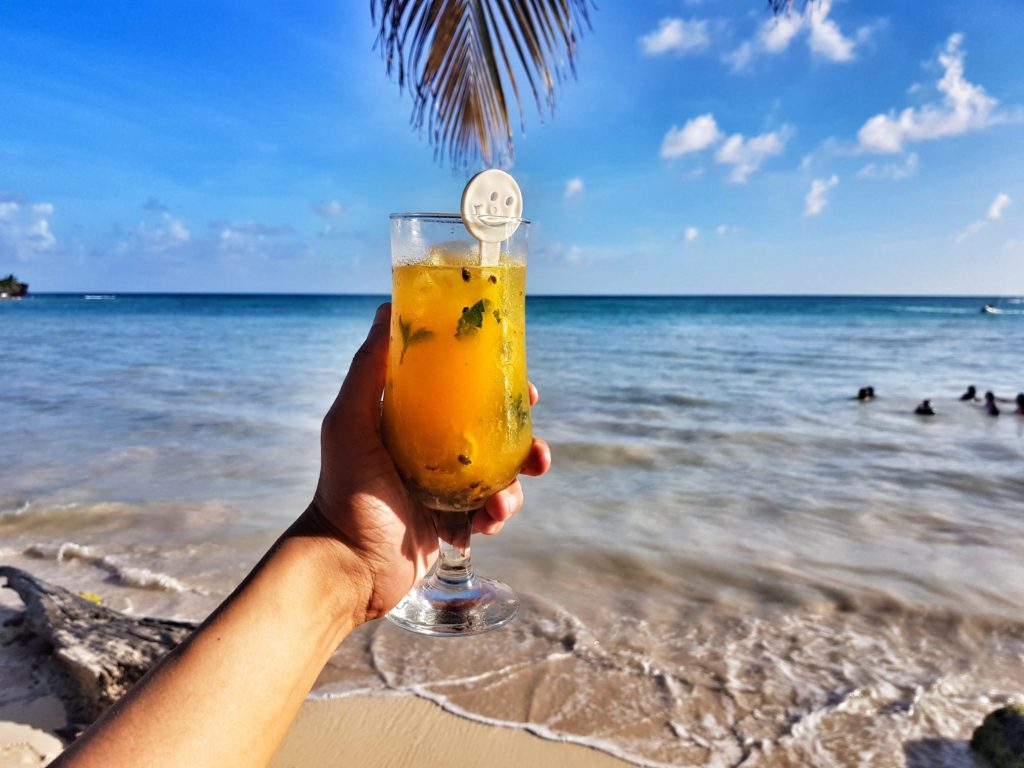
We stopped at several beaches, had a few cocktails, had a swim in the sea and enjoyed the beautiful views. Then, we started again from the beginning. It doesn’t take long to drive around the island. Maybe 45 minutes without stops. Maybe one hour. But that’s what we did.
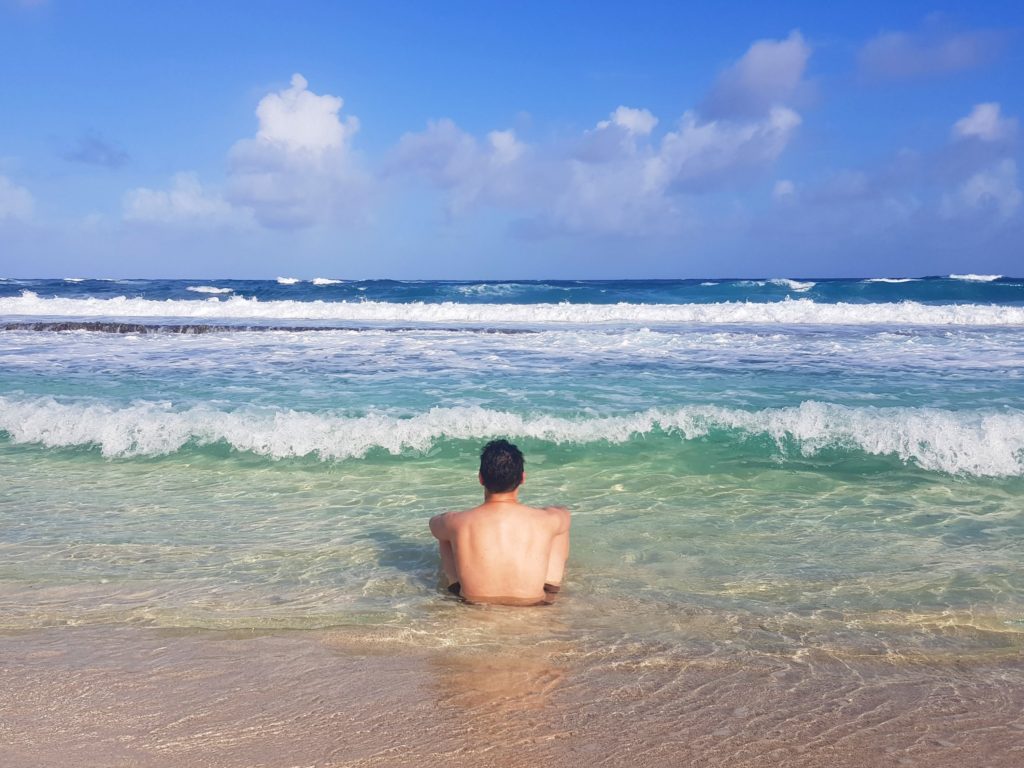
To be honest, there isn’t very much to do in San Andrés apart from driving around from one beach to another, but that was just fine. We also found out that the island is rather a destination for domestic tourists than for Non-Colombians. San Andrés is a tax free zone. That attracts many Colombian tourists, who buy their yearly supply of cosmetics on this island. Alcohol is also way cheaper than on the mainland.
Nevertheless, Tobi and Jasmin found an activity for the day after: diving. The both are passionate divers, and this should be their first dive during their world trip. I used the time alone to drive around. Seriously, I could have done that all day long.
We met again in the early afternoon and continued doing the same thing we did the day before: cruising around, checking out new beaches and swimming in the ocean.
Although we enjoyed the second day as much as the first, I was ready to leave the day after. I am not a beach-bum and two days at the beach are actually enough for me. My flight to Medellin would have been at 14.30 the next day, while Tobi and Jasmin had their flight at 9.45. Surprisingly, I found out that this flight was still available for 35 Dollars only. The flight I booked back home cost more than 100 USD, and it was not even a direct one but with a transfer in Cartagena. It could be very possible that the low cost of the flight was because I was using a Colombian SIM card. Needless to say that I purchased the ticket right away.
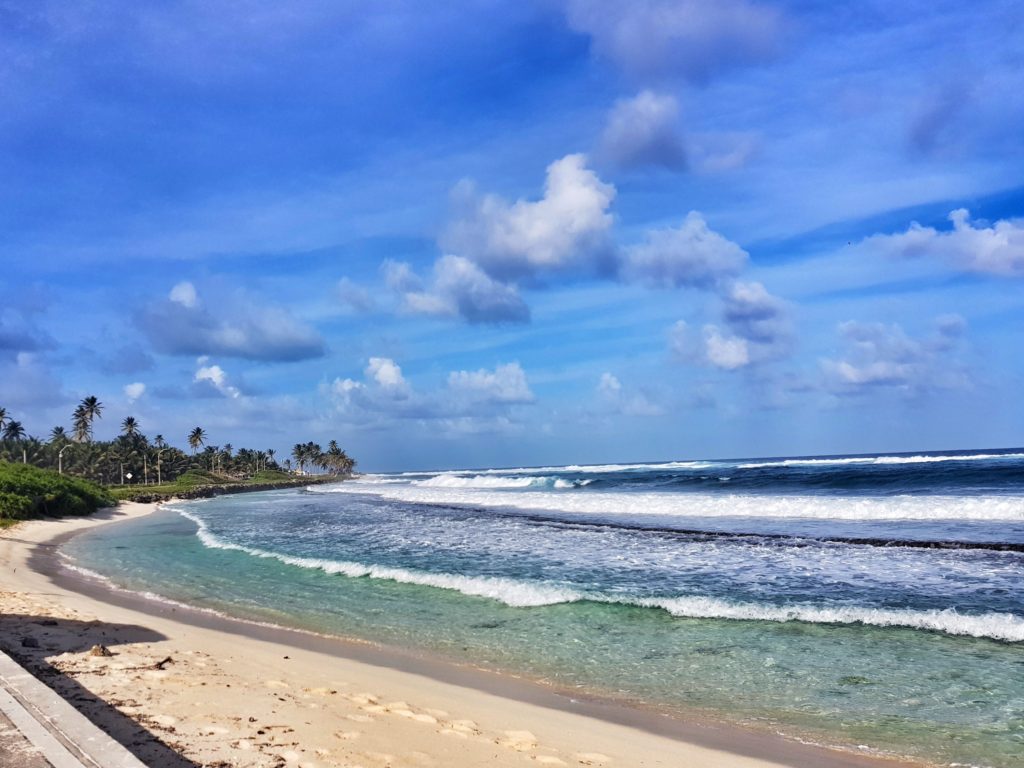
In hindsight, traveling to San Andrés was a great idea. Although San Andrés is more expensive than mainland Colombia, it’s probably still one of the cheapest tiny islands in the Caribbean you can find. The Caribbean is one of the most expensive parts in the world after all, and here you can get it for a bargain.
We didn’t leave the island without one last good story. I was already at the airport the next morning, when Tobi and Jasmin arrived. The owner of their hostel, who didn’t want to open the doors for them at 4 AM three days ago, wasn’t amused when the two woke her up at 8 (!!!) in the morning. They couldn’t leave because the door was locked so they had no other choice than knocking on the lady’s door. Getting woken up at 8 AM was apparently a pure impudence for the lady. Her insults to Tobi and Jasmin led to a 3/10 review on booking.com, which seemed to be too harsh for booking.com so that they didn’t publish it. 🙂
That wasn’t the good story though. Tobi and Jasmin walked from their hostel to the airport, when suddenly a guy appeared who wanted to prevent them from entering a narrow street. “You cannot enter this street, they would immediately rob you guys!!” The young Colombian showed them the safe way to the airport afterwards. This dangerous street was just two or three minutes away from the airport!
When I was back home, I did some research. Apparently, this tiny paradise island isn’t as safe as it seems to be. While I always felt safe in San Andrés, they say that the island has some dangerous areas, especially the one adjacent to the airport. I walked the five minutes between the airport and my hotel after my arrival at midnight, but some websites claim that you should take a taxi no matter how close your hotel is. I was lucky, I guess.
Medellin
Medellin was our last stop in Colombia before we left the country towards Ecuador. Our first idea was to stay five nights, but we eventually cut one night in order to have more time in Ecuador. Another idea I skipped was spending one night in Cali before going to Ecuador. Most people, even Colombians, say that Cali isn’t worth a trip.
It didn’t take long until I fell in love with Medellin. I already witnessed the beauty of this city on the route from the airport to El Poblado, the traveler’s district. Medellin looks special. If I had to describe the city in two colors, my answer would be green and red. Medellin is surrounded by green hills, and almost all houses are colored in red or have a red roof at least
The city is generally very colorful, as you can see beautiful graffiti everywhere. I also had the impression that Medellin was quite modern. The streets looked alright in El Poblado, the houses well-maintained and it seemed to be pretty relaxed here. I later found out that this assessment was correct for the Poblado district but not for the entire city.
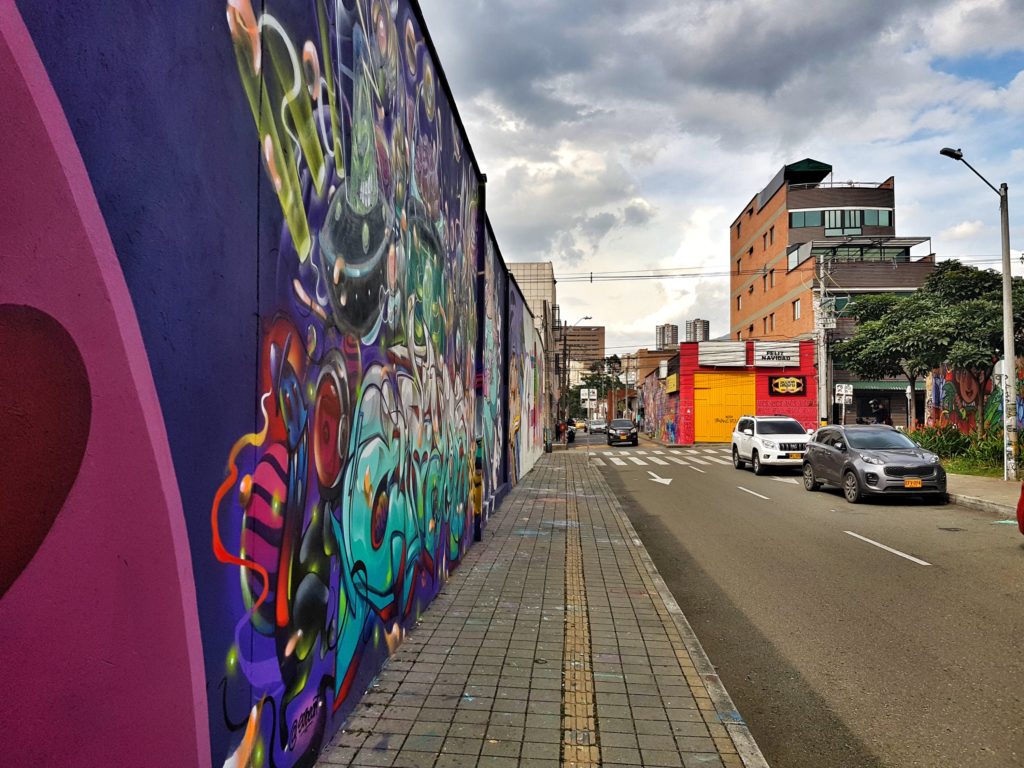
Tobi and Jasmin had their hostel close to my apartment. It was a little street full of other hostels, cafés and restaurant. A perfect place to hang around a few days. I had booked a huge apartment near Parque Poblado. I really needed a bit of luxury after the three nights in the posada.
We weren’t as active during our first afternoon in Medellin and spent some time in a mall, where I recharged the data volume of my SIM card (I already used 2GB in the first four days). However, we used the second day to see the city. Like in many other South American cities, a cable car connects different parts of the city to each other. We thought that riding the cable car might be a good opportunity to get a real impression of the city.
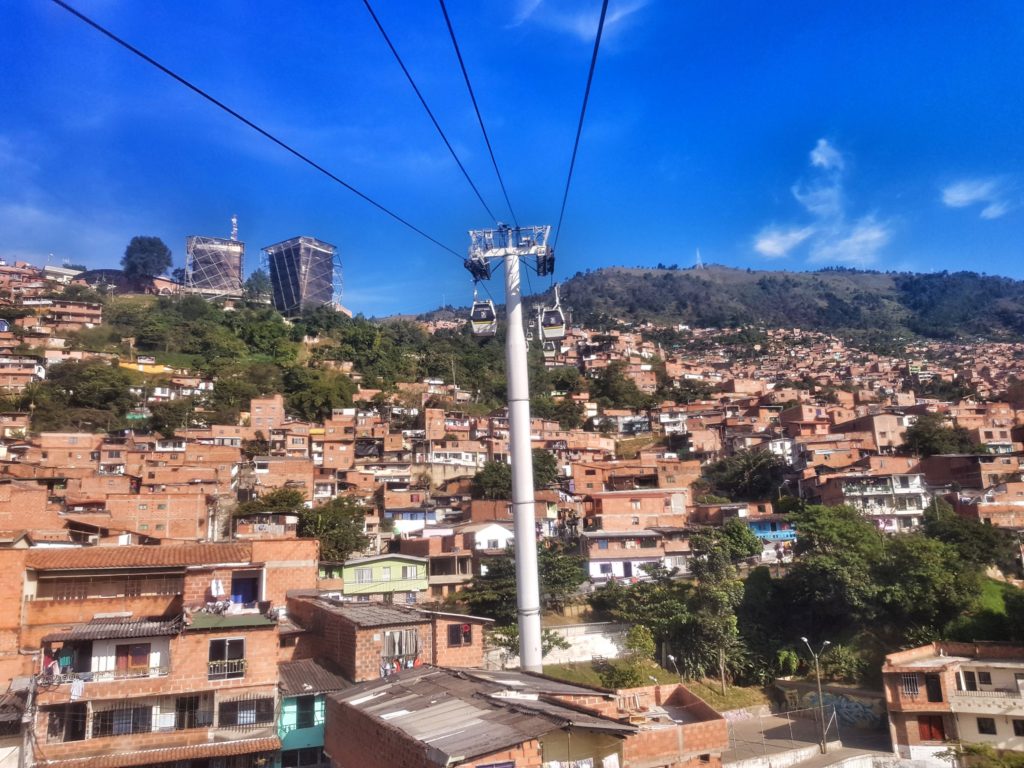
I am not sure if my assumption is correct, but I thought the higher we got the poorer the neighborhoods got. The houses we saw reminded me of the favelas I saw in Brazil. The view over Medellin was absolutely spectacular though.
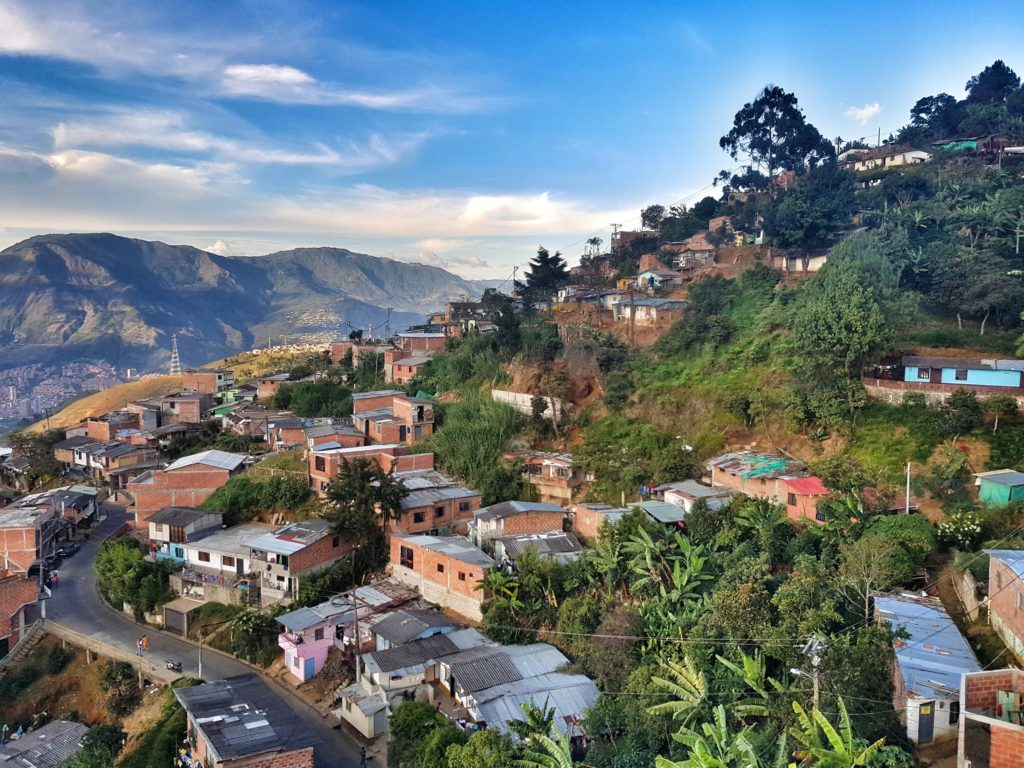
Interestingly, the cable car didn’t let us out at some view point but in the middle of nowhere. We were on top of a hill with no view but surrounded by forest. You can do hikes from there, and one of them would get you to a view point eventually. A guy who worked up there told us that it’s highly advised to do this tour with a guide, as it would be too dangerous to do it on your own. “Oookay, let’s take the cable car back to the city” we said. The attraction is the ride itself and not what you can see up there.
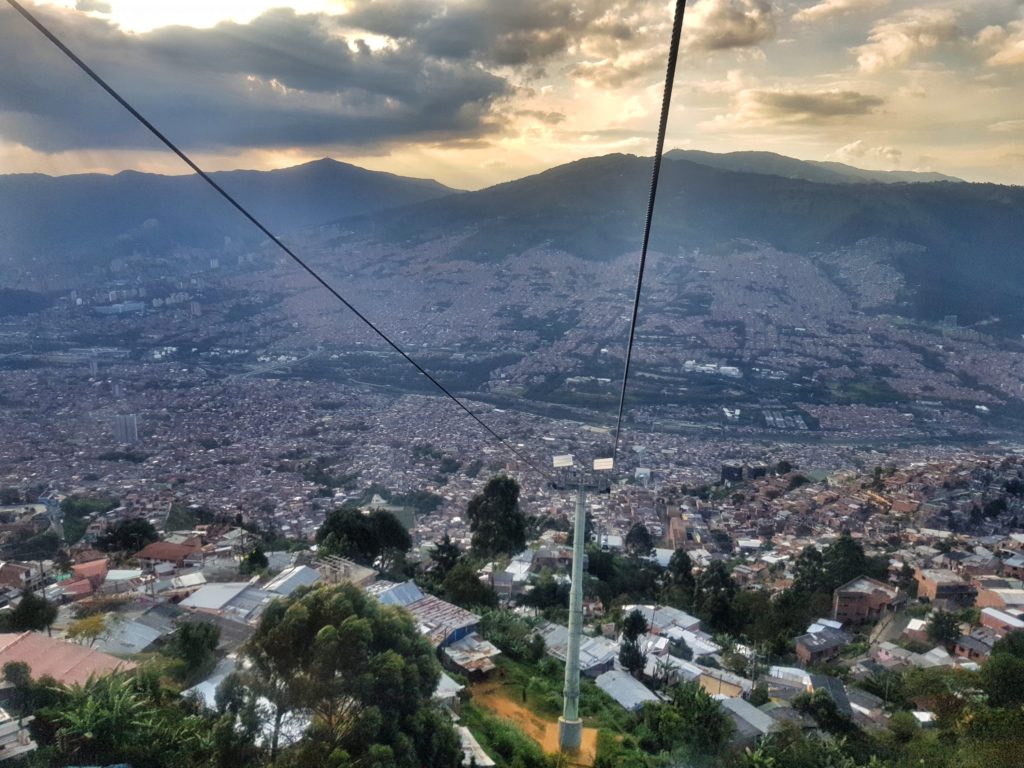
We still had a bit time left and went to Parque Botero, a park full of sculptures in Medellin’s Old Quarter. I had the feeling that my two friends rated it as the most underwhelming experience during their world trip, and it’s true somehow, as it is not really a must-see in my opinion.
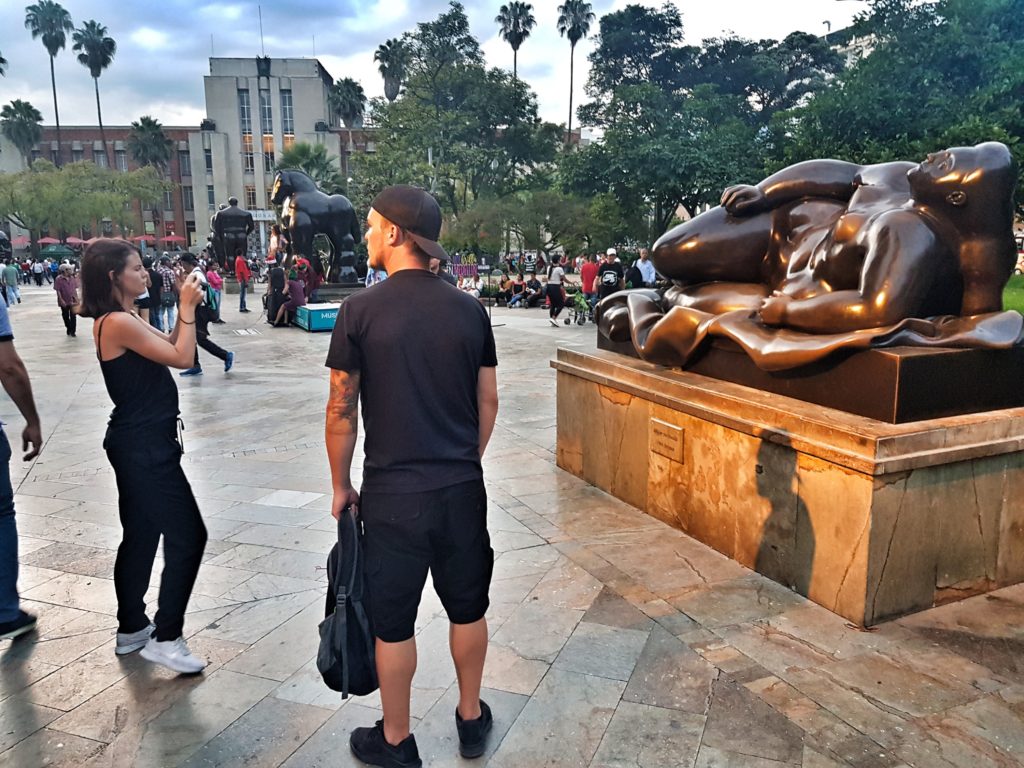
In hindsight, I’m still glad that we went there. This area of the city looked completely different than El Poblado. It was chaotic, dirty and hectic compared to the quiet and relaxed atmosphere in El Poblado.
What came next was an almost one hour Uber ride from the park back to El Poblado. I’m telling you, sitting in a vehicle during Medellin’s rush hour is horrible! Horrible is even an understatement, unless you enjoy being stuck in traffic jam for ages. Seriously, that was the only thing I really didn’t like about Medellin. Everything else was great.
A day-trip to Guatapé
No trip to Medellin is complete without visiting Guatapé. Several tour operators offer day-trips to this tiny town just about one and a half hours away from Medellin. The best thing is that most of these tours cost less than 80,000 Pesos (24 USD).
After a rather unspectacular stop in a little town on our way, we arrived at the Peñón de Guatapé shortly before noon. This gigantic rock had one of the weirdest stair constructions I have ever seen, and it was obvious that going up was part of the tour. Tobi, who had already been to Colombia a few years ago, kept talking about this “very exhausting climb” for days. I expected the worst.
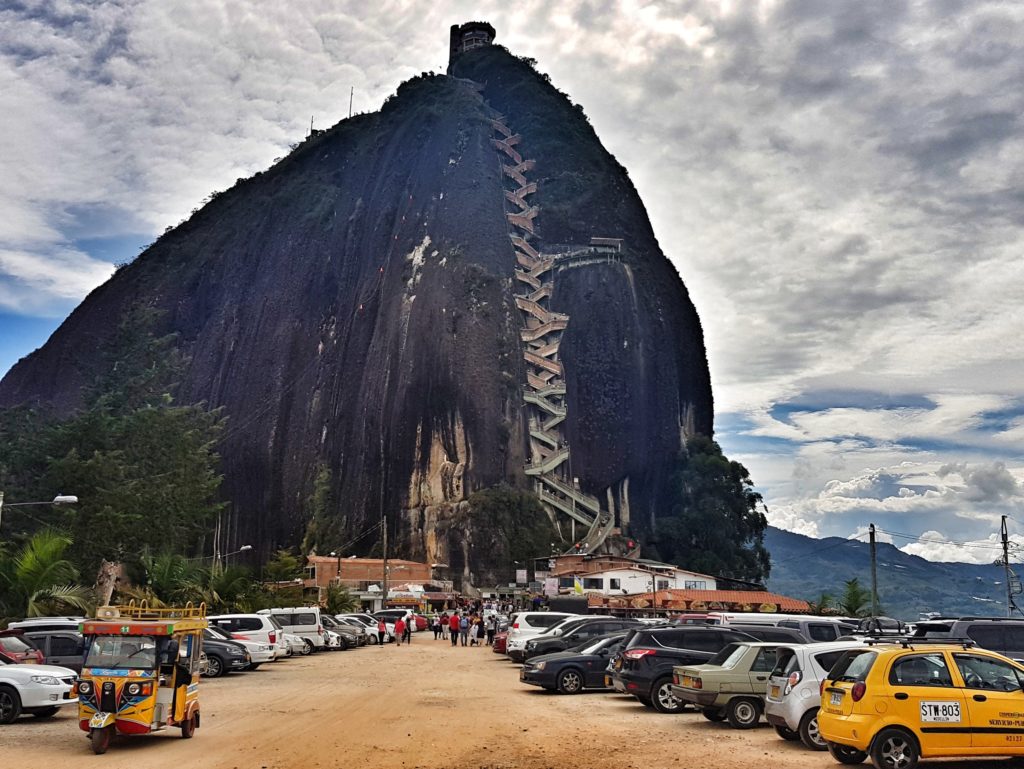
However, I was more than surprised when we reached the 250th out of 740 steps after only three or maximum four minutes. In the end, it took only about ten minutes to get up there, and it’s comparable to climbing up the tower of a church somewhere in Europe: a bit demanding but absolutely doable.
The view you get on top of the rock is worth all the effort. Guatapé is home to a huge man-made reservoir, and the top of El Peñon rewards you with a 360 degree view over a stunning landscape.
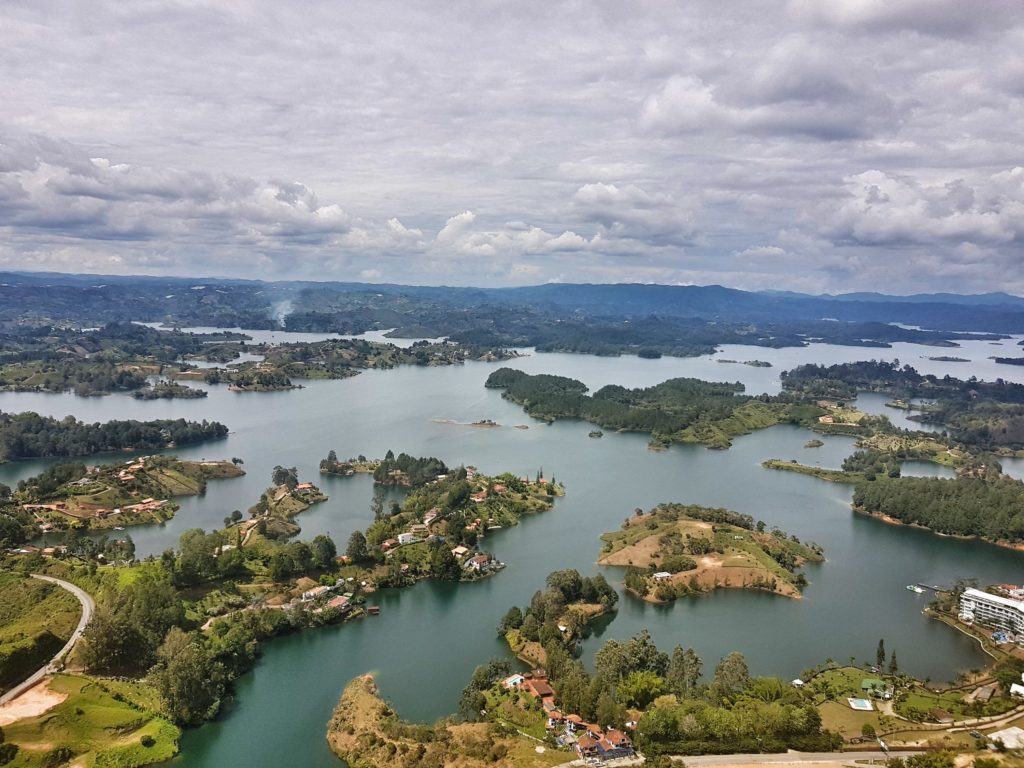
What impressed me even more was the town of Guatapé. This tiny town with only a bit more than 5,000 inhabitants was the most colorful village I have seen in the entire world. There is even a law in this town that the facade of the houses must be decorated.
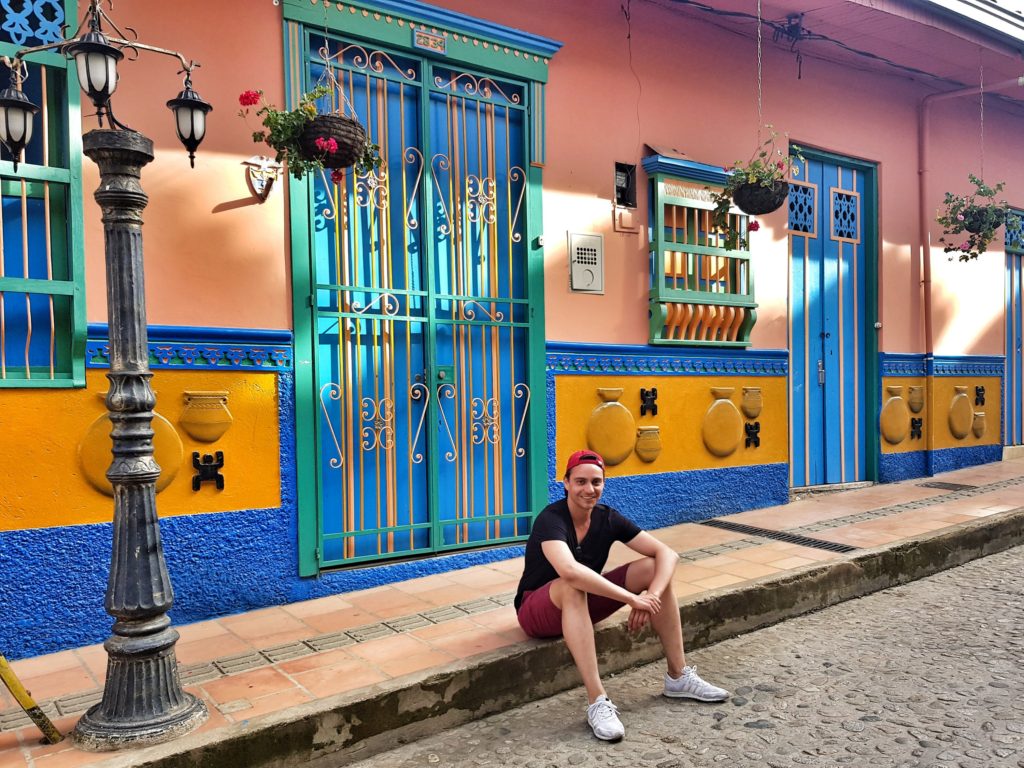
Guatapé is unsurprisingly one of the most visited places in Colombia. It’s super-touristy but definitely worth a trip. Although the town is very small, it offers enough beautiful streets and houses to spend a few hours there. We arrived in Guatapé with the whole tour group (one big bus) and they led us through they narrow streets like a herd of sheep. Fortunately, they later gave us more time to explore the town by ourselves.
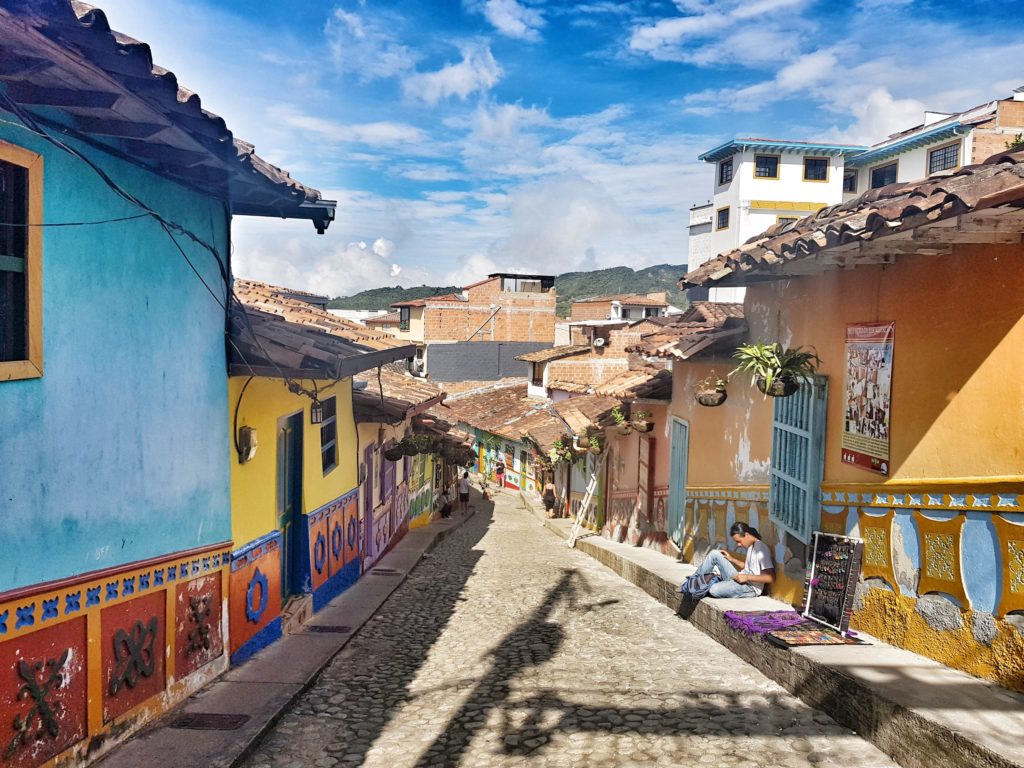
In the end, Guatapé was one of my highlights in Colombia. It’s one of the most charming towns I have ever seen, and I wished that I could have stayed longer.
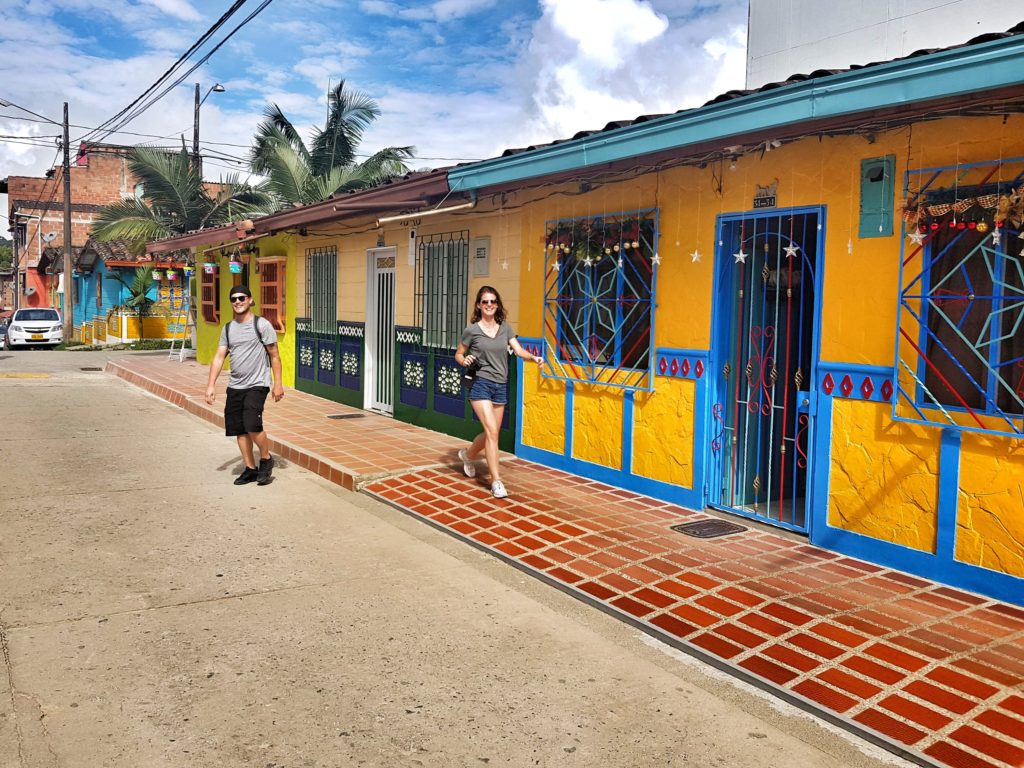
Comuna 13: history lesson & graffiti
While I didn’t do the graffiti tour in Bogota, I signed up for the one in Medellin. That also gave us the opportunity to test Medellin’s metro. The metro is Medellin’s pride, as they have one while the capital doesn’t. However, taking the metro wasn’t a nice experience at all…
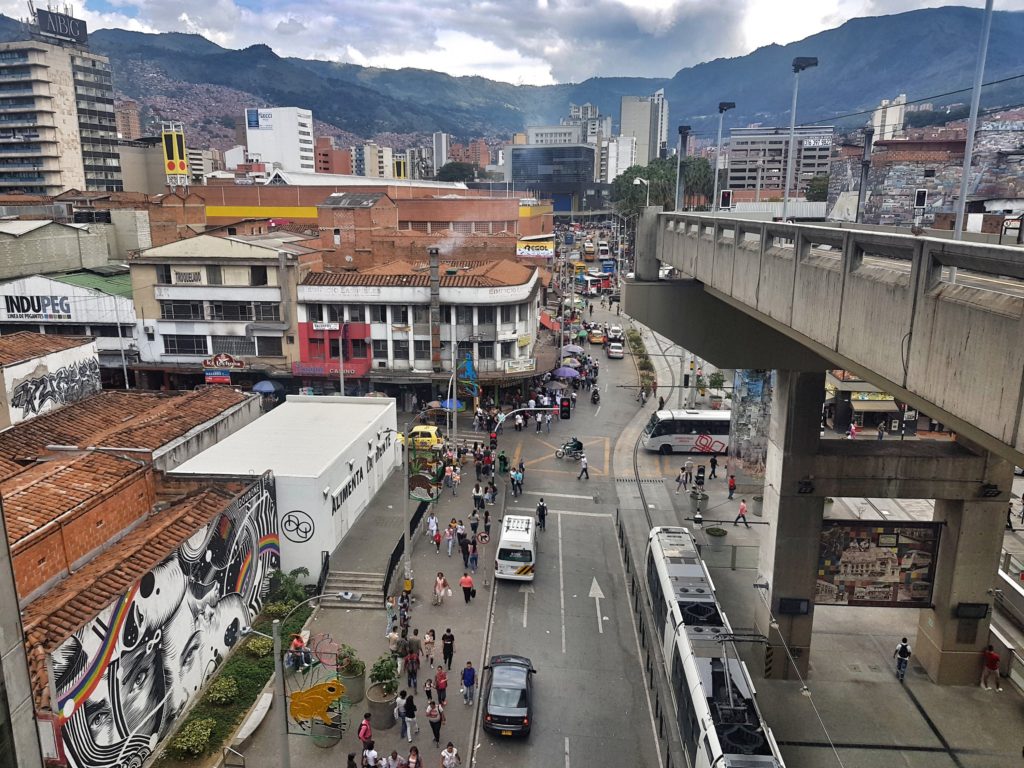
I have seen more people in that metro than in Tokyo’s subway during rush hour. It was hot, the air was bad, and I had the constant fear that someone might take my wallet or my cellphone out of my pocket. The nightmare ended half an hour later and I was never happier to leave a metro.
So, we were on our way to Comuna 13. You might ask what Comuna 13 means? It actually means nothing else than district 13. There are 16 districts in Medellin and all of them have numbers. El Poblado, for example, is Comuna 14, although both districts are far away from each other. Don’t ask about the logic here.
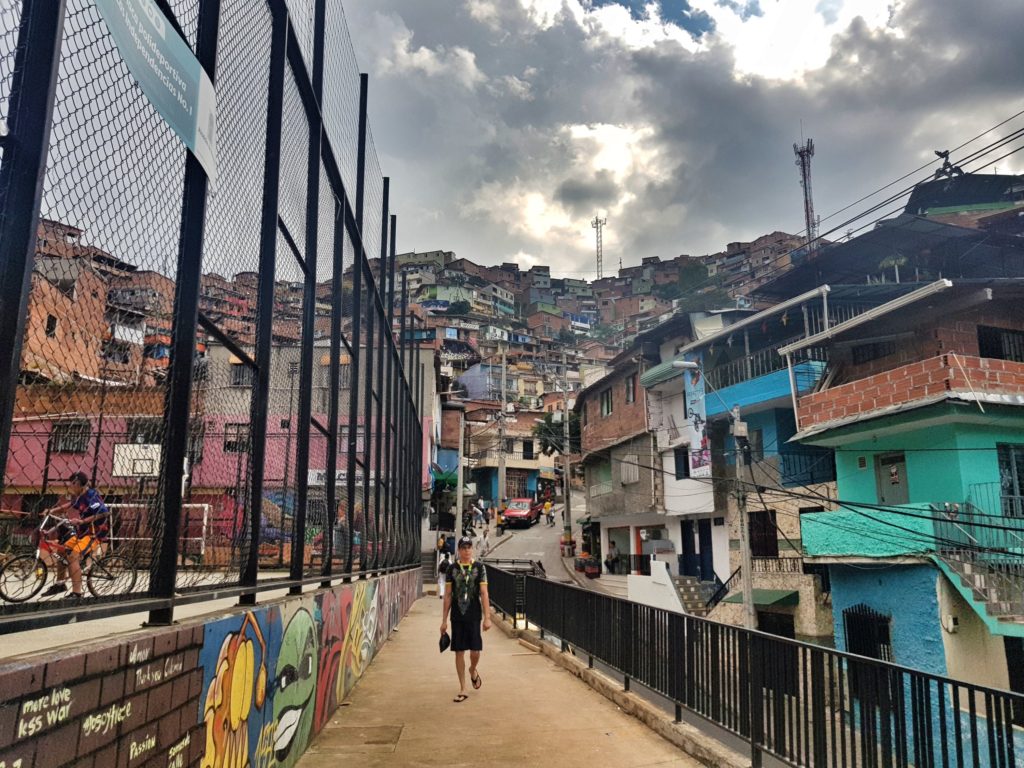
Before we entered Comuna 13, our tour guide got us a brief introduction about Medellin and Comuna 13. This comuna had a rather troubled past. Medellin used to be one of (if not THE) most dangerous city in the world only a few decades ago. Moreover, Comuna 13 was probably the most dangerous district within the city.
This district used to be a battlefield for drug traffickers, paramilitary, guerillas and gangs because of its ideal location. The neighborhood leads directly to San Juan Highway, from where the transportation of drugs was very easy. To say that Comuna 13 was a rough place back then is an understatement, as this district had one of the highest homicide rates in the world.
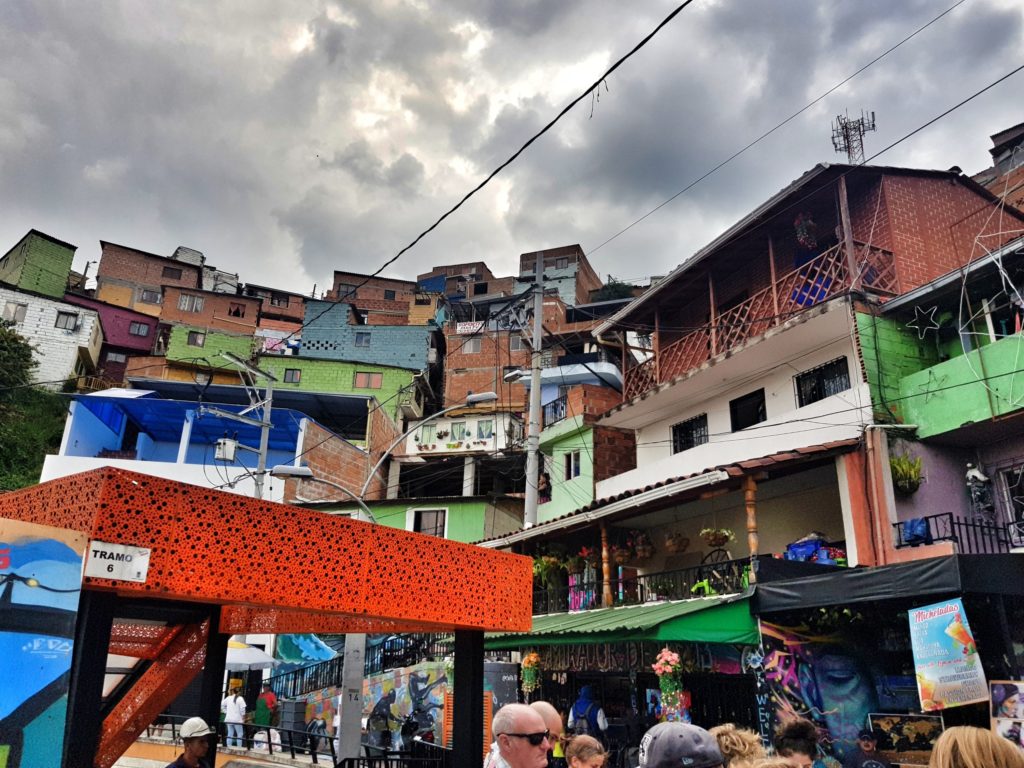
Times have changed though. Comuna 13 is more or less safe nowadays. That doesn’t mean that it’s a 100% safe neighborhood, as it is still a very poor district. However, the times of gun battles around the densely built houses are over. I would even go as far as to say that visiting Comuna 13 on your own is possible today, however, you would miss the opportunity to hear the interesting story about the neighborhood.
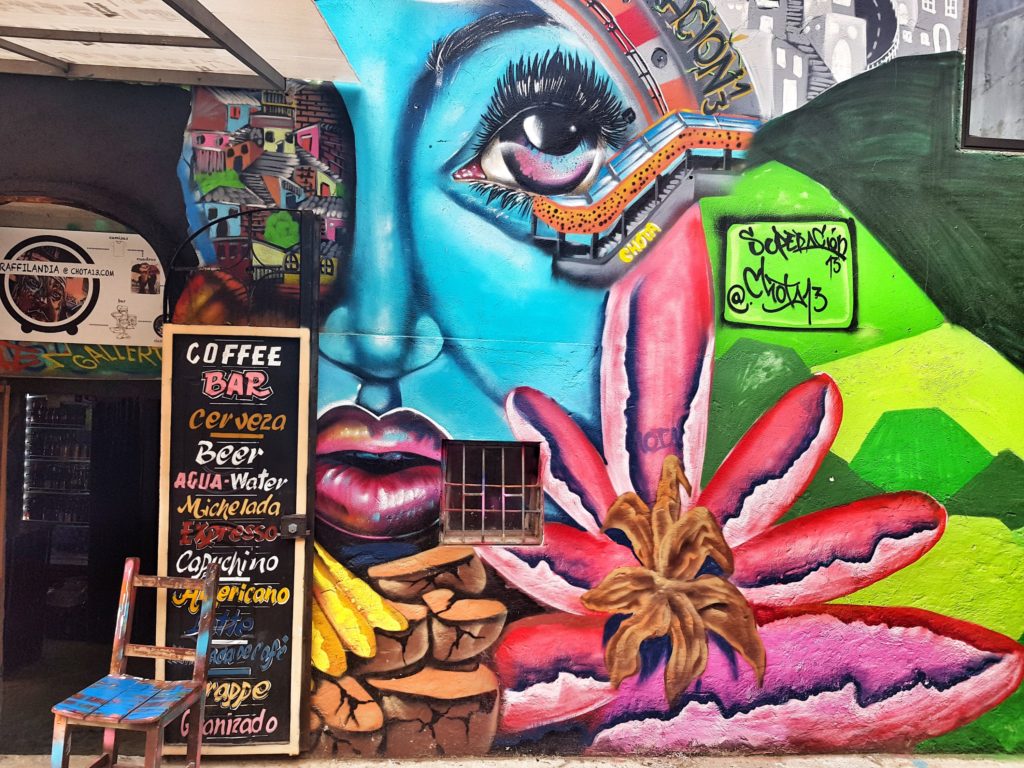
Some of the graffiti tours in Comuna 13 are free (tip-based), some cost about 20,000 Pesos and some are more expensive than the day-trip to Guatapé. We opted for the tip-based tour. Our tour guide, who was born and raised here, gave us two rules before we entered the comuna. We shouldn’t touch the numerous stray animals and we shouldn’t give money to the begging kids, as they wouldn’t go back to school otherwise. And before you ask: yes, we saw many stray dogs and also a few begging children.
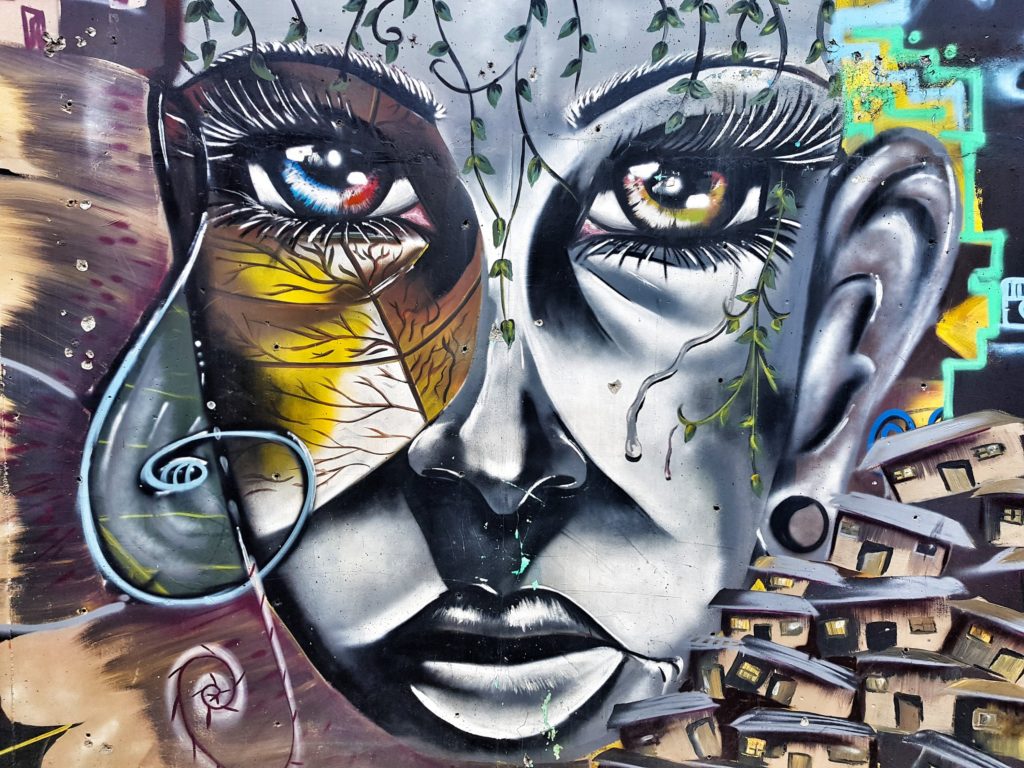
The graffiti we saw on the tour were outstanding, and they were literally everywhere. Graffiti is something I always associate with South American cities. I have seen nice street art in Manaus, in Lima, in Cusco, but the street art I have seen in Medellin was without a doubt the best.
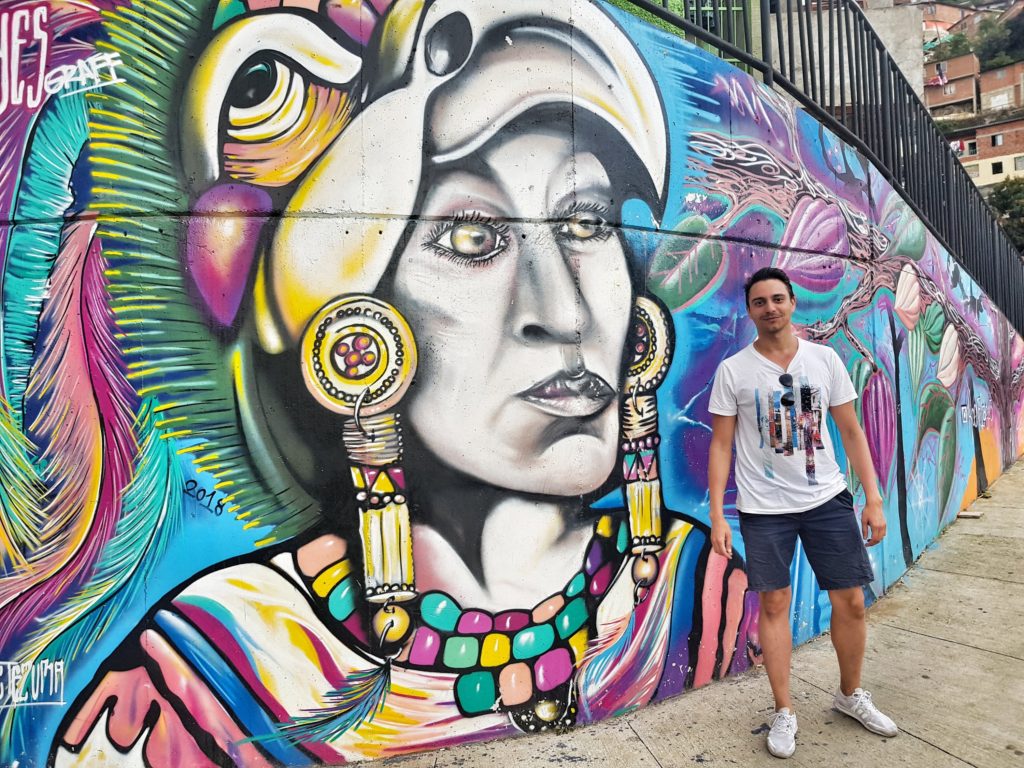
The rules in Comuna 13 are simple: everyone can create a graffiti. However, if you want to put a graffiti to a wall that already has one on it, you have to ask the creator of the original one if you can use that space. The answer will either be a no or a yes with the condition that the new graffiti has to be better than the existing one. What happens when someone creates the graffiti of the year but he or she didn’t ask for permission first? The graffiti has to be removed then.
This graffiti tour was more than just about street art. It gave us an insight to the Colombian psyche. Many Colombians actually worry about the reputation Colombia has. Colombia has been a violent country for many years. Although these times are over now, it seems that the country is still an extreme travel destination to many people. During the tour, our guide frankly said she hopes that we would tell the truth about Colombia when we are back home. And the truth is that Colombia is an amazing country with warm-hearted people that has nothing in common with a war-zone.
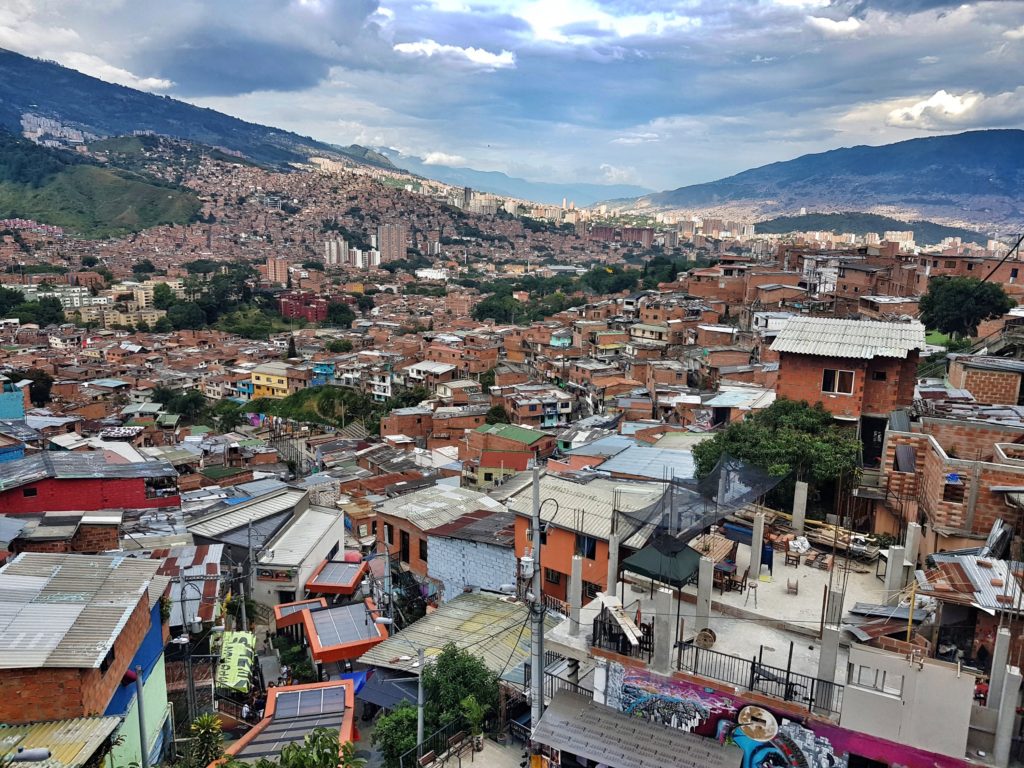
The Comuna 13 graffiti tour is probably the best free activity the city has to offer. It doesn’t only show the participants beautiful street art, but also teaches some lessons about the history of Colombia. Plus the participants are visiting a neighborhood they probably wouldn’t go to without a guide.
Pablo’s grave
Another activity I wanted to do in Colombia was visiting Pablo Escobar’s grave. Sort of a dark tourism activity.
I read a book about Pablo Escobar’s life a few years ago and was fascinated about the story. Not only the war between Escobar and the Colombian government was thrilling but also the hunt for Pablo that included several US-American organizations such as the FBI, DEA, Special Forces that all hadworked against each other for different reasons.
Narcos is one of the most popular series on Netflix right now. It’s about Pablo Escobar and definitely another reason why more and more people travel to Colombia every year. There are specific Narcos tours for these tourists. The Netflix documentary Dark Tourist even shows the host of the show how he’s interviewing a former contract killer who worked for Pablo Escobar.
In the end, I didn’t go to Escobar’s grave…
I’m not sure if the Comuna 13 tour changed my mind for good, but it definitely supported my decision. During the tour I realized that the former drug lord still remains a critical issue among the Colombians. Also, when I was googling the location of Escobar’s grave, I read an article about rapper Wiz Khalifa, who appeared at the grave with flowers and a joint. That led to an outrage of many Colombians. Although Escobar had many followers in Colombia, he was also responsible for the deaths of many.
Eventually, everyone has to make his/her own decision whether visiting Escobar’s grave is a good idea or not. And I’m not blaming anyone who does it. I have visited many sites with a dark history and I will continue doing that, as I believe that this is also part of understanding the world. But this time, I just felt that it wouldn’t be right…
Colombia is simply amazing!
Colombia is a country that blew me away. I spent 10 days there, which is of course a bit short for a country of that size. However, I liked Colombia so much so that I think that I will be back rather sooner than later.
So, what makes Colombia such a great travel destination? First of all, it’s a very diverse country. You will find here colorful cities, nice islands, the Amazon rain forest, beautiful shores, mountains and wildlife. Second, Colombians are just amazing people. They are aware that the reputation of Colombia isn’t the best after decades of violence, and they give their best to show visitors the welcoming and warm side of the country.
Third, Colombia is more modern than other South American countries such as Peru and Ecuador. Colombia is a third world country, but from what I had seen it’s not a destitute country, and I believe that many Colombians are doing more or less fine. Forth, Colombia is a very cheap country to travel. Accommodation doesn’t cost a fortune, restaurants are cheap and so is the transportation, no matter if taxis, buses or domestic flights.
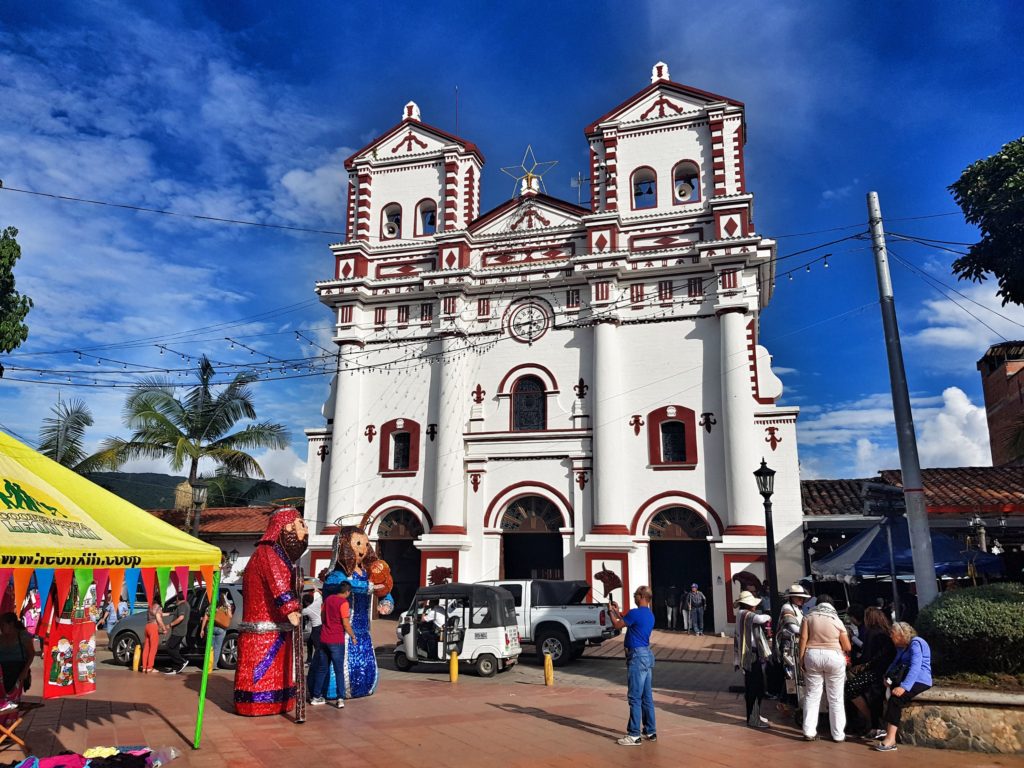
When I created my itinerary for Colombia, I didn’t take Cartagena into account. Colombia’s most touristy city didn’t interest me anymore after hearing more and more negative stories about it. Cartagena seems to be a polarizing destination though. Some people love it, some people hate it. However, after this first trip to Colombia, I changed my mind. I believe that the north coast offers enough for two more weeks in the country. There is not only Cartagena in the north, but also places like Barranquilla, Minca, Taganga etc. I might combine that with Venezuela someday.
Many people are not sure whether Colombia is a safe country or not. Colombia is perfectly safe to travel nowadays. Of course, there are some areas a traveler shouldn’t visit, but people traveling the tourist route shouldn’t worry. Although it’s still South America and robberies are possible, most of the tourists will be fine in the end.
It comes as a surprise to many that I haven’t traveled to all the usual countries yet. They assume that after traveling to 78 countries I have been everywhere and only countries like Equatorial Guinea, Kiribati and Tajikistan remain. That’s not the case though. There are many common travel destinations I haven’t been to yet. Colombia was one of them. And in the end, I am glad that I waited so long until I traveled to this country. Although I have seen a lot of the world, there are still pearls out there. Like Colombia.
Find the travel reports of the other countries I’ve visited here!
